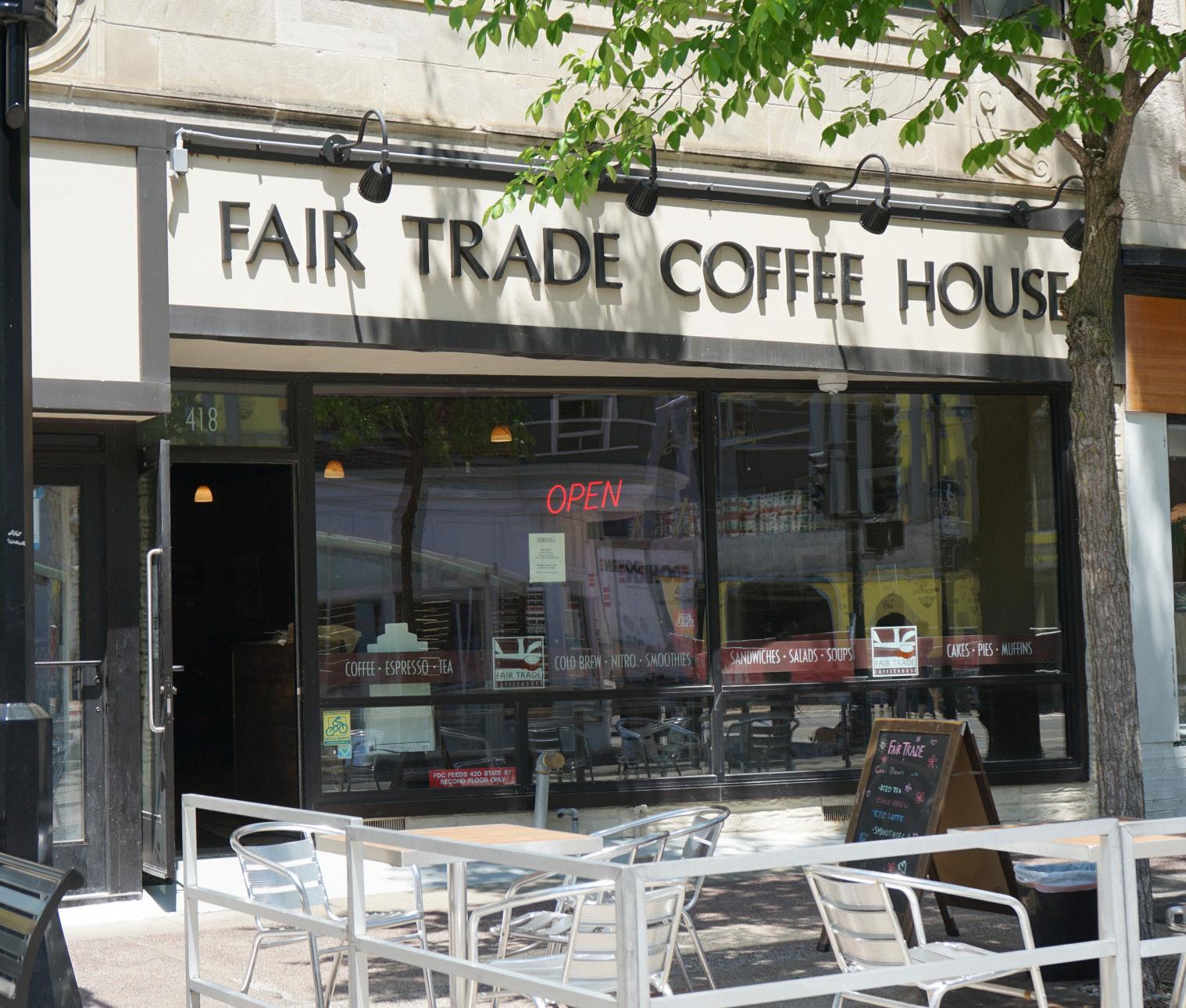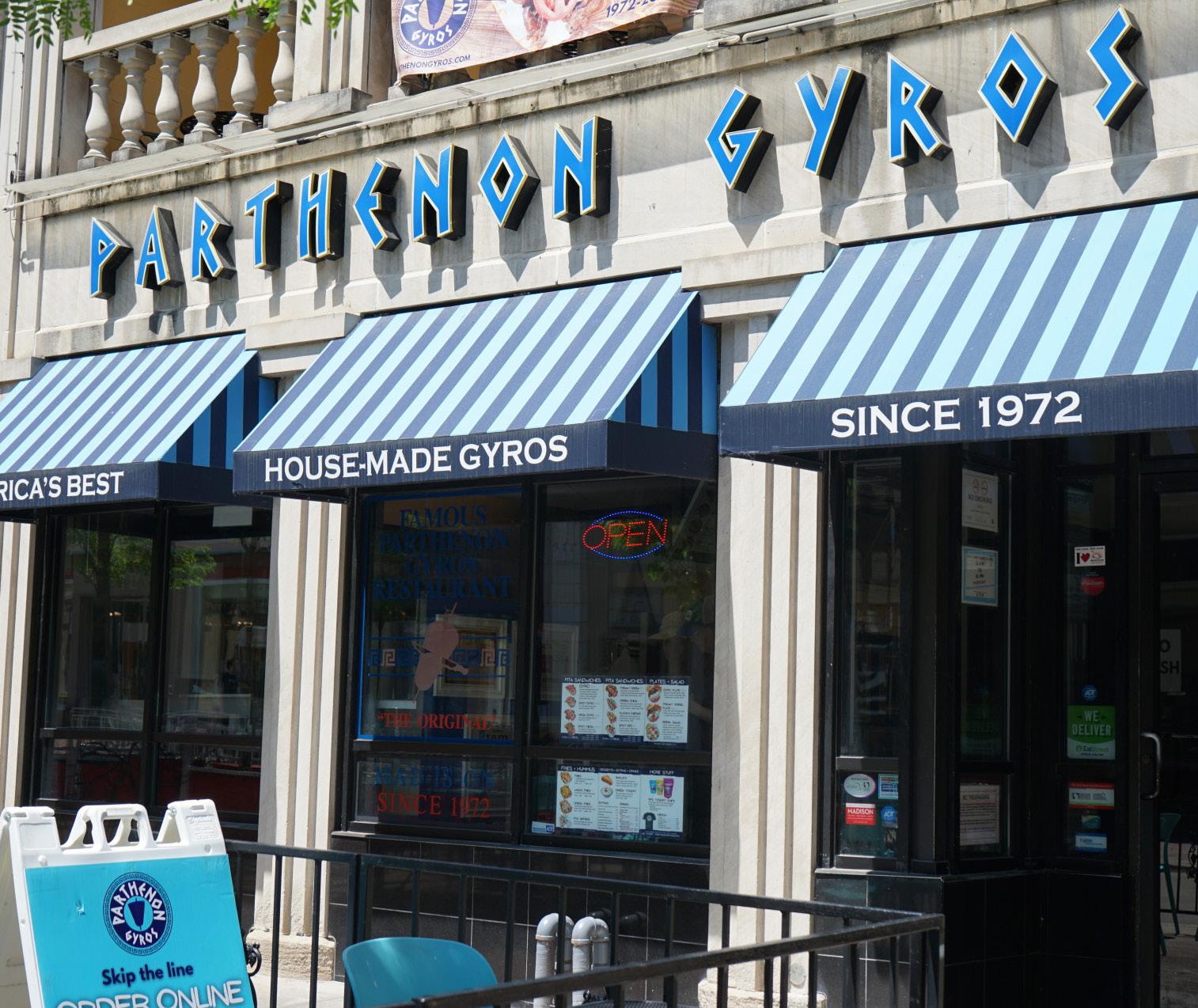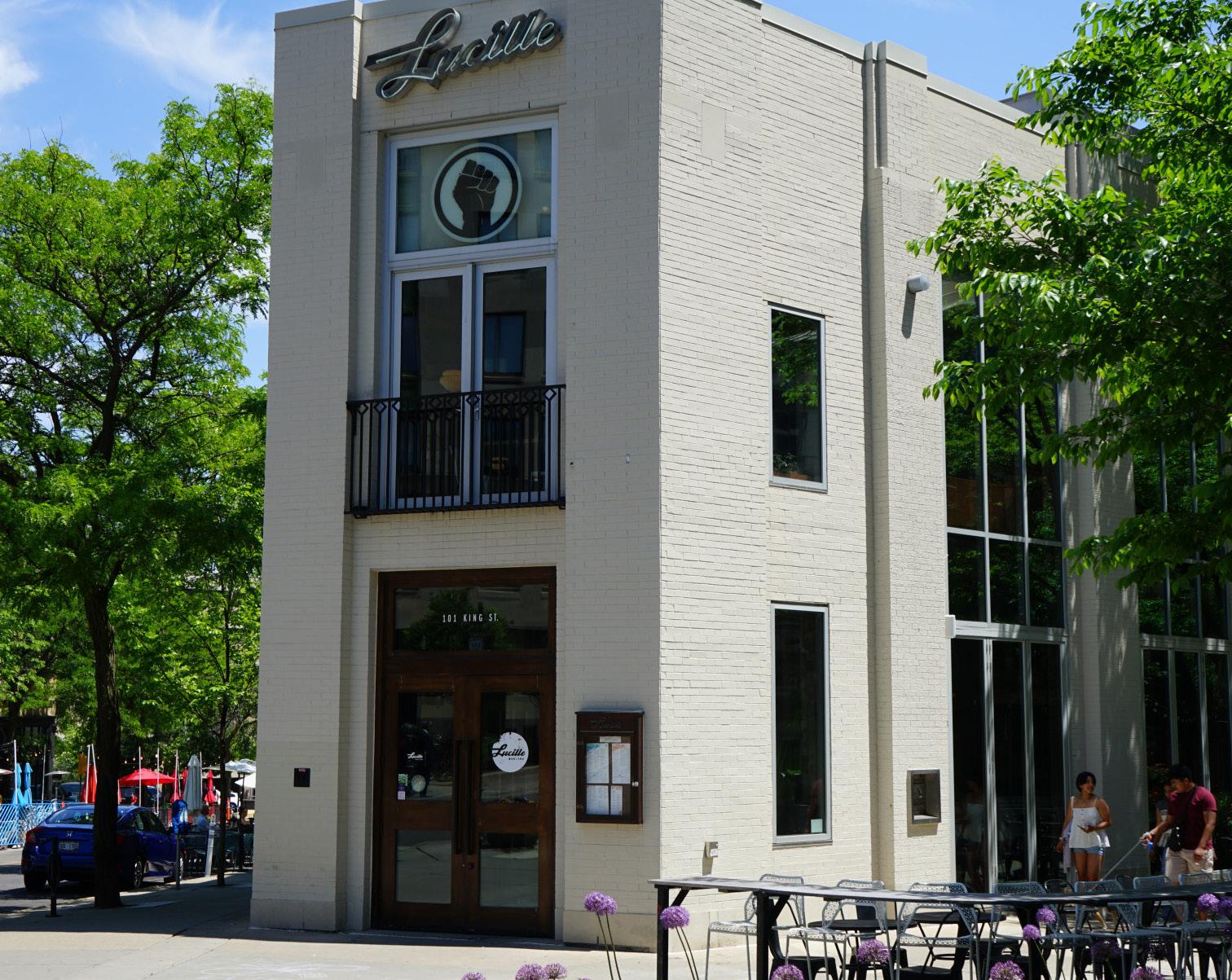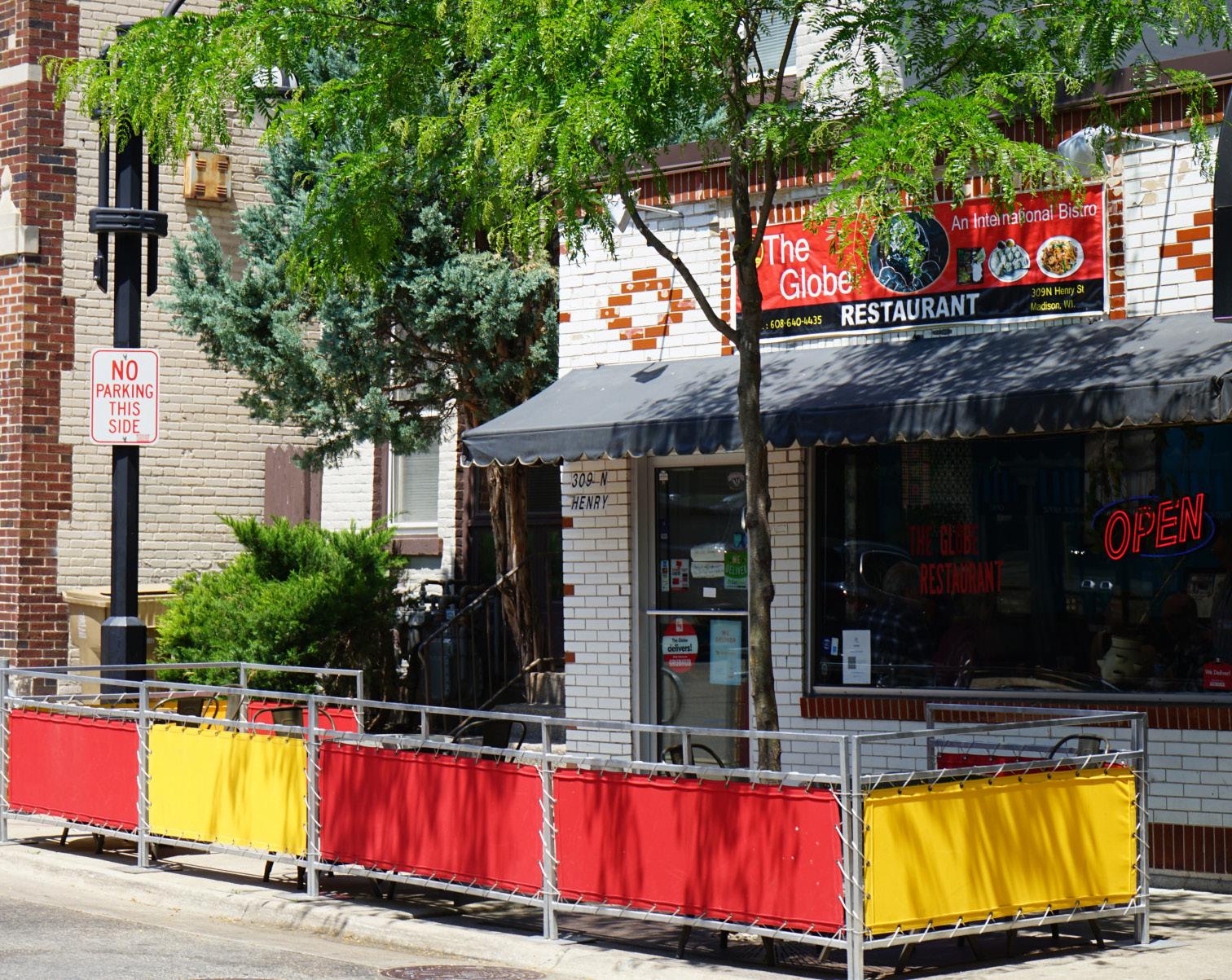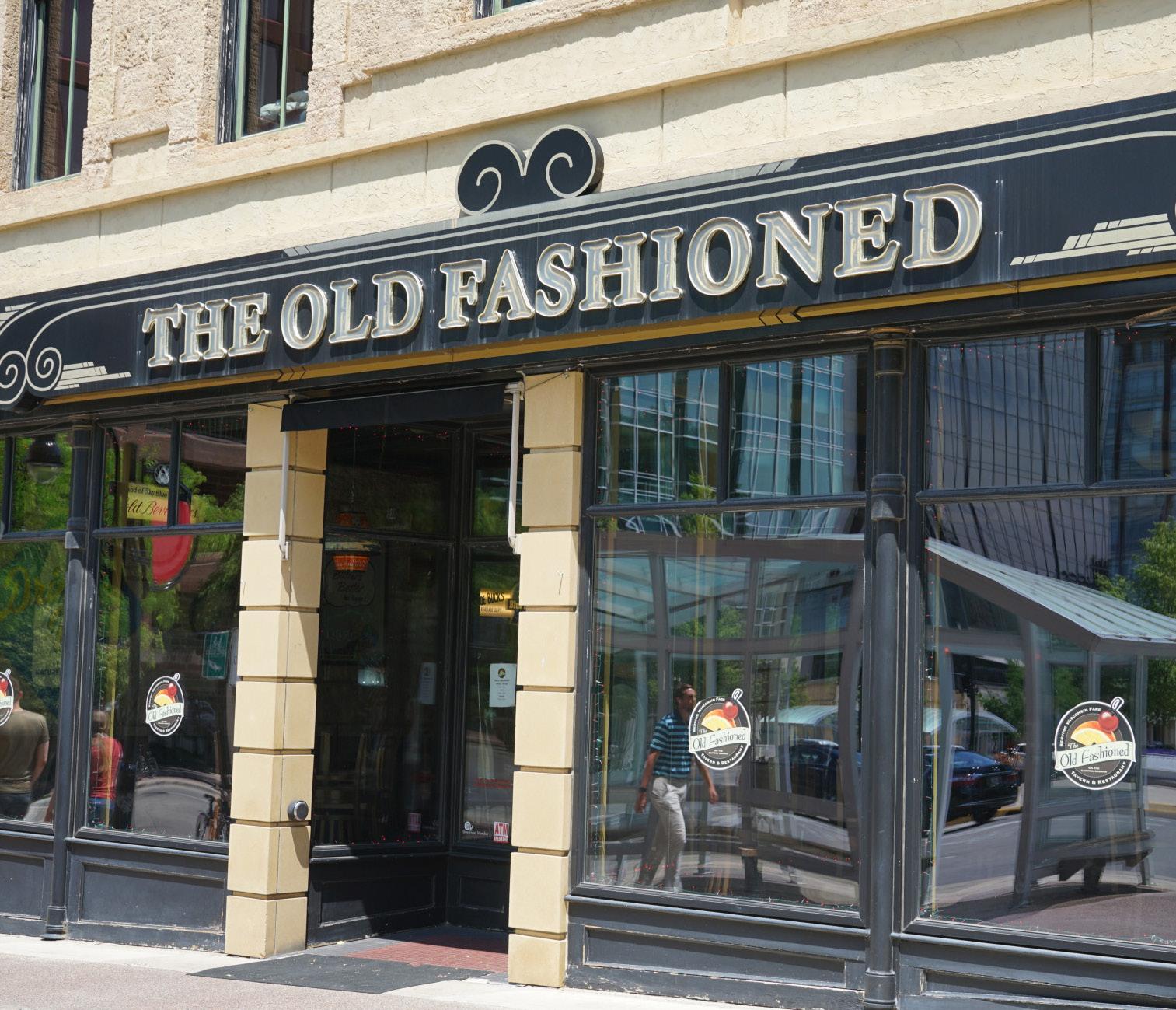

Editor-in-Chief Drake White-Bergey Managing Editor Tyler Katzenberger



Editor-in-Chief Drake White-Bergey Managing Editor Tyler Katzenberger
The University of WisconsinMadison language sciences department is o ering its first ASL course at the university, Linguistics 351: American Sign Language 1, in the fall of 2023.
The course sequence aims to help students communicate in ASL, which includes “producing and comprehending ASL across a wide variety of contexts and social settings, a thorough overview of ASL grammar and structure, an understanding of appropriate pragmatic usage and knowledge and appreciation of Deaf culture and history,” according to the language sciences website.
Twenty students are enrolled in the course and a full 40 students are on the waitlist as of June 6, according to UW-Madison’s course search and enroll app.
The university plans to o er ASL 2 during the spring semester so students can continue in the sequence, according to the language sciences department. The four-credit course fulfills the university’s language requirement. In comparison, CDC 424 — the existing two-credit communication sciences and disorders course that emphasizes basic signs in ASL and Manually Coded English — does not fulfill that requirement.
worked as an ASL instructor for students of all ages and in a variety of settings, including community groups and private companies like Goodwill. Koss is looking forward to teaching at a university for the first time.
“The college level is on the top of my list to teach,” Koss wrote in an email to The Daily Cardinal. “From [my past teaching] experiences, I was very fortunate to work and teach with them and [become] a successful instructor.”
Koss stressed the importance of the course for UW-Madison students and the Deaf community for several reasons. For one, ASL instruction allows the Deaf and hearing communities to communicate, facilitating more inclusion for the Deaf community.
“By teaching ASL, I contribute to creating a more inclusive society by bridging the communication gap between the Deaf and hearing communities,” Koss wrote. “It allows deaf individuals to fully participate in various aspects of life, including education, employment and social interactions.”
Koss also emphasized the importance of ASL to Deaf culture and of sharing and advocating for the Deaf community with students.
subscription sales.
The Daily Cardinal is published weekdays and distributed at the University of WisconsinMadison and its surrounding community with a circulation of 10,000.
Capital Newspapers, Inc. is the Cardinal’s printer. The Daily Cardinal is printed on recycled paper. The Cardinal is a member of the Associated Collegiate Press and the Wisconsin Newspaper Association.
All copy, photographs and graphics appearing in The Daily Cardinal are the sole property of the Cardinal and may not be reproduced without written permission of the editor in chief.
The Daily Cardinal accepts advertising representing a wide range of views. This acceptance does not imply agreement with the views expressed. The Cardinal reserves the right to reject advertisements judged offensive based on imagery, wording or both.

Complaints: News and editorial complaints should be presented to the editor in chief. Business and advertising complaints should be presented to the business manager.
Letters Policy: Letters must be word processed and must include contact information. No anonymous letters will be printed. All letters to the editor will be printed at the discretion of The Daily Cardinal. Letters may be sent to opinion@ dailycardinal.com.
Editorial Board
Graham Brown • Tyler Katzenberger
• Em-J Krigsman • Charlotte Relac •
Priyanka Vasavan • Drake White-Bergey • Ethan Wollins
Board of Directors
Scott Girard, President • Ishita
Chakraborty • Don Miner • Nancy Sandy
• Phil Hands • Nathan Kalmoe • Josh
Klemons • Barbara Arnold • Jennifer Sereno
The new course is instructed by Taylor Koss, a deaf athlete and current ASL instructor at La Follette High School in Madison. UW-Madison joins other area universities such as Madison College, UW-Milwaukee and the University of Minnesota-Twin Cities with existing ASL courses.
Koss graduated from the Wisconsin School for the Deaf and began a degree in world languages at UW-Milwaukee in 2020. He has
“Teaching ASL allows me to share the rich cultural heritage, history, traditions, values and beliefs of the Deaf community,” Koss wrote. “I can help dismiss misconceptions and promote a more inclusive society by educating others.”
“ASL has its own syntax and grammar,” he continued. “It is important for UW-Madison to understand why ASL is important and to add language to the [university’s] program.”
Darrell Roby, president of the
Madison Association for the Deaf, discussed the potential impacts of the course beyond UW-Madison in an email to The Daily Cardinal.
“Funding and committing university resources to a course related to the Deaf community can have several positive impacts beyond the university and within the Deaf community,” Roby wrote. “[This includes] education and awareness, empowerment, increased accessibility, collaboration and partnerships, workforce diversity and social change.”
Amy Free is an ASL interpreter at UW-Madison who works in a variety of settings on campus, including anything from large events with thousands of people to one-on-one meetings with deaf students. She spoke to the importance of proper ASL instruction from deaf instructors who can discuss the Deaf experience and teach ASL in an appropriate manner.
“I find it hopeful that on our campus, [the ASL course] will bring exposure to people to the
right way to learn language, from a person who can actually speak to Deaf experiences,” Free said.
Free also discussed why she chose to study ASL and o ered her advice to future UW-Madison ASL students.
“Take the course if you want to commit to learning more,” Free said. “It’s not easy — it’s going to take work outside of class. You can’t study abroad for ASL, so think about going to some Deaf events and get some immersion.”
Free also shared hopes that the ASL course would help deaf students who communicate using ASL to be able to communicate with more students on campus.

“This is a hearing university, and that can be isolating for a Deaf student,” Free said. “I think if we can imagine more students having exposure to ASL, being comfortable and not afraid of Deaf people — and being comfortable with trying to sign — eventually some of that isolation could [be reduced].”
The University of WisconsinMadison will open the Rebecca M. Blank Center for Campus History on July 1 as a continuation of a campus-wide Public History Project, which has been operating for the past four years.

As UW-Madison’s Public History Project comes to a close, the Rebecca M. Blank Center for Campus History will make its debut as a continuation of the project and a step toward implementing the university’s history into UW-Madison courses and curriculum.
© , The Daily Cardinal Media Corporation
ISSN -5 98
The center is named for the late Chancellor Emerita Rebecca Blank, who led UW-Madison for nine years and oversaw the Public History Project during her tenure.
The Public History Project explored the stories of “those who experienced and challenged bigotry and exclusion on campus,” according to its website. The multi-year research project culminated in a Chazen Art Museum exhibit, “Sifting and Reckoning,” which was open to the public last fall.
The project will conclude on July
1, with the Rebecca M. Blank Center for Campus History launching the same day, said John Zumbrunnen, UW-Madison vice provost for teaching and learning.
The new center will build on the work of the Public History Project, Zumbrunnen said. It will be housed in the Division for Teaching and Learning and directly connect to campus-wide teaching practices.
“[I’m] most excited about the ways in which what we learn about the history of this place can be present in classes,” Zumbrennen said.
According to Public History Project Director Kacie Lucchini Butcher, an initial center sta meet-
ing was held on May 24 to discuss months of listening sessions across campus. Zumbrunnen said these listening sessions allowed project sta to hear from organizations across campus. The center’s establishment is a point of pride for Zumbrunnen. In his view, the full time three-person sta and support from UW-Madison students have helped make the center a unique entity.
Zumbrunnen highlighted contributions UW-Madison students made to the center’s development, including participating in research through the university’s archives, brainstorming discussion questions for listening
sessions and creating blog posts to spark excitement.
“It is how an educational institution ought to proceed,” Zumbrunnen said. “I always found it really, really powerful to have students learn about, engage with [and] discuss the history of student activism and protest on this campus.”
The establishment of the Blank Center for Campus History will also set an example for other universities and institutions, according to Zumbrunnen. While other universities have explored parts of their past, he said UW-Madison’s years-long exploration of its entire history sets it apart from other institutions.
Zumbrunnen said the center connects not only to campus history but history in the United States as a whole, adding that UW-Madison and its history is a “microcosm” of the nation’s history.
The center will continue to develop as Lucchini Butcher and colleagues work to implement it on campus.
“[The center presents] an incredibly wonderful opportunity to learn not just about this campus but more broadly about history,” Zumbrunnen said.
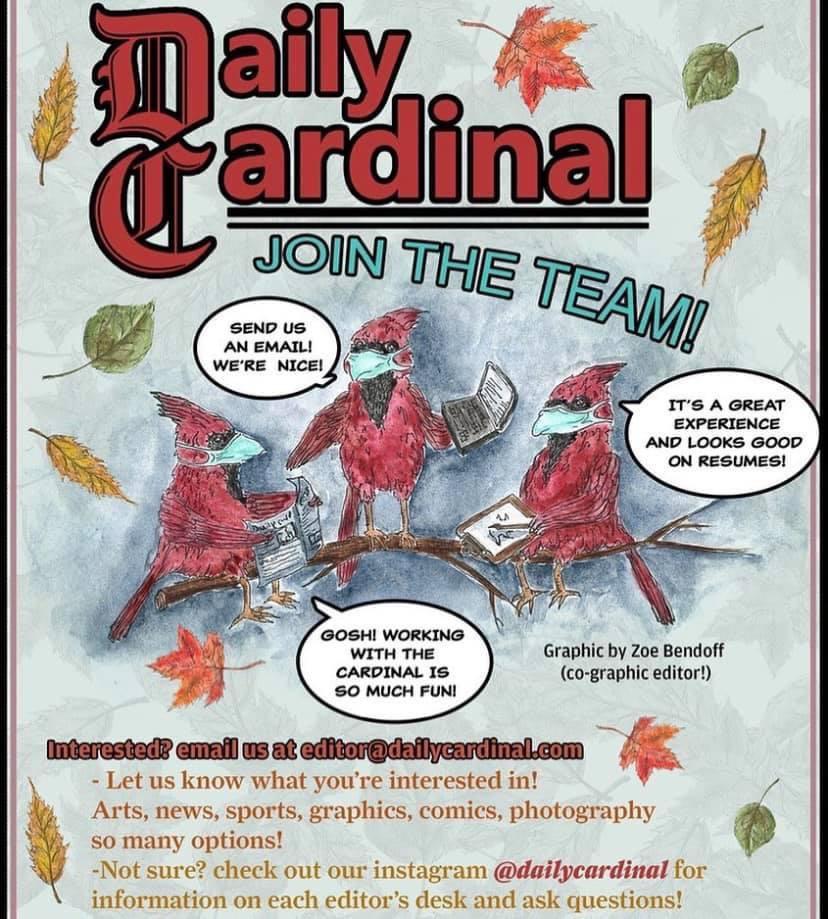
For many recent University of Wisconsin-Madison graduates, the 2022-23 academic year was considered the only “normal” year of their college journey. Following the commencement ceremony on May 13, recent graduates reflected on how COVID-19 impacted their college experience.
COVID protocols began on March 11, 2020, when thenChancellor Rebecca Blank announced the suspension of spring 2020 study abroad programming. The following day, Gov. Tony Evers declared a state of emergency due to COVID-19. From then on, UW-Madison responded to the pandemic by suspending in-person instruction on March 23, 2020, and implementing various protocols for students and faculty.
Recent UW-Madison grad-
uate Carissa Ackermann explained how the pandemic’s impact began while she was living in Witte Residence Hall.
“I remember [in] late February, -early March, COVID being a joke — until it wasn’t,” Ackermann said. “We were hearing on the news that the virus was spreading, but it didn’t feel like it would really a ect our college life until the day [The] Ohio State University got sent home for an ‘extended spring break.’ I remember thinking, ‘Uh oh, this is really real now.’”
Kaden Buck started the pandemic living off-campus after transferring from UW-Milwaukee. He explained how he returned to his hometown after the start of COVID19, where he was grateful to have a family to support him.
“I was living by myself when
I came to Madison because I didn’t know anyone here when I transferred here, and I think my experience was very similar to everyone else where there was a lot of uncertainty,” Buck said. “Going home didn’t feel real at that time, and I’m grateful that I had a really supportive family.”
Travis Cooke explained his initial reaction to COVID-19 as a freshman living in Sellery Residence Hall.
“I was pretty excited that I got extra time off of school,” Cooke said. “I didn’t really know what to expect. It was up in the air.”
Emily Pessefall felt greater anxiety during the rise of COVID-19.
“I remember being pretty anxious about it because my mom is a Type 1 diabetic,” Pessefall said. “If I got sick, then she would get sick because I was living with her after we moved out of the dorms.”
The following academic year, Chancellor Blank released a statement updating students on COVID protocols where she explained the mode of class instruction, testing procedures and her goal of normalcy for students.
But for students returning to a campus filled with strict testing protocols, near-ubiquitous virtual classes and empty buildings, the year still felt isolating.
Megan Cantor was living in her sorority house that year, where she experienced various protocols to minimize the spread of the virus.
“If a girl tested positive for COVID, the whole house would quarantine,” Cantor said. “If another person tested positive, the quarantine restarted.
While masks were required, we rarely were able to leave.”
Ackermann also lived in a sorority house and experienced similar protocols. She explained similar di culties she faced during this time.
“Classes were all online, obviously, and campus buildings were pretty shut down with the exception of making reservations to go sit at some of the bigger ones,” Ackermann said. “As someone who really struggles to get work done at home, this was a really di cult year for me.”
During the next 2021-22 academic year, Malik Staude explained how a sense of normalcy reemerged after he transferred from UW-Milwaukee to UW-Madison.
“Everyone was definitely still going to class in masks and things like that, and that was a bit newer because the year prior I had only done basically online,” Staude said. “Going back to class for the first time since March of my freshman year was a little bit jarring.”
Buck also noted how he noticed COVID-19 changed the operations of the university and the attitudes of students.
“A lot of professors or instructors I had would choose to do Zoom classes,” Buck said. “Some still had concerns about the pandemic while others just found it more convenient. I think that left a lot of students disengaged, just as a result of the pandemic.”
Cooke explained how his final year at UW-Madison felt like his only “normal” year.
“We didn’t finish freshman year, sophomore year wasn’t normal, junior year wasn’t normal,” Cooke said. “Senior year was basically back to normal — where I was the first semester of my freshman year.”
Ackerman, despite grievances with some university policies throughout the pandemic, felt the university did the best it could given the situation.
“There was nothing to model this plan of action o , and though I might not agree with every
small detail of the situation, most students were given the option to be in Madison for the majority of their college experience,” Ackermann said. “For that, I am very grateful to UW because that was not possible everywhere.”
Staude had a similar outlook on how the pandemic was handled by the university.
“They did what they could do,” Staude said. “No one was really trained for this, they had no idea what to do, and, I think in terms of going to Zoom and things like that, the professors handled it pretty well for how much they know about technology and how novel this situation was.”
The graduates had various opinions on how the pandemic impacted their overall college experience.
“You go to college not only to get a degree and an education, but there is a huge social aspect of college,” Cooke said. “They say it’s ‘the best four years of your life,’ but realistically two and a half [years] were stripped from me.”
Cantor explained her frustrations with how the pandemic impacted her as a student.
“I think COVID made it harder to connect with classmates and professors,” Cantor said. “I also think it didn’t give people a chance to meet new people. Virtual school made me stir-crazy, and I don’t think I actually learned a thing due to lack of motivation.”
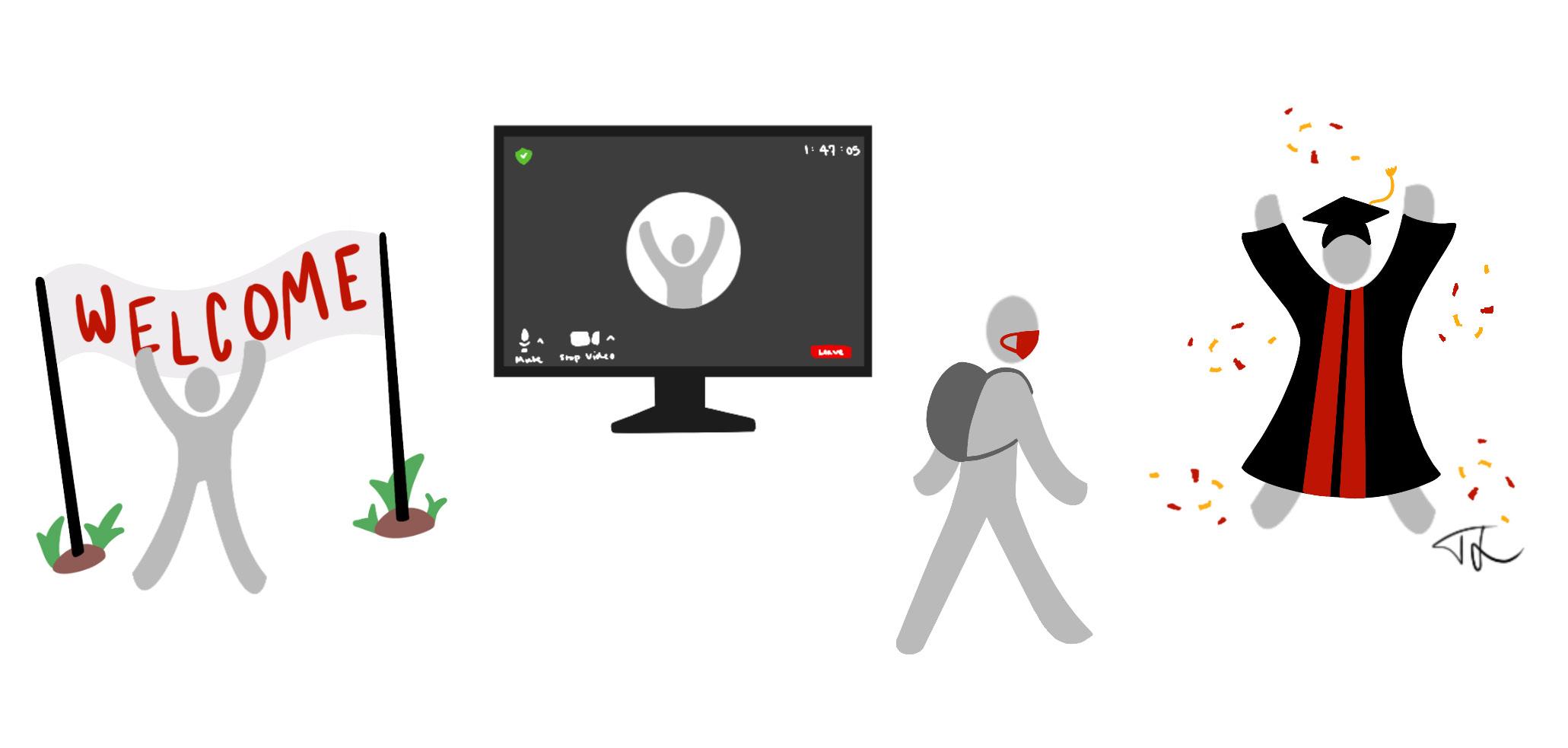
Ackermann noted that although the pandemic brought various hardships throughout her college career, she was still able to make the best of the situation.
“I would say that though COVID definitely had its e ects, it was all part of the journey,”
Ackermann said. “I still made life-long friends, [and] had formative experiences and created memories that might not have happened the same way in a ‘normal’ college experience.”
Madison’s Metro system will undergo its biggest change in over 20 years on June 11, changing all 2,000 bus stops in some way.

The City of Madison approved a redesign of the entire bus system in December with the goal of providing
more consistent service and direct routes. Most routes will switch from numbers to letters, and all transfer points will be eliminated.
The 80, 82 and 84 campus bus routes frequented by UW-Madison students will be similar to their current routes, according to Rusch. Route 81 will change so that the bus
doesn’t travel down State Street.
Mark Rusch, interim chief development officer for Metro Transit, told The Daily Cardinal the changes will address community complaints regarding long bus rides, frequent transfers and confusing routes.
Equity was at the forefront of the redesign, according to Mayor Satya Rhodes-Conway.
“The whole premise of the network redesign is to create a more adequate equitable system,” Rhodes-Conway said at a press conference last month, the Cap Times reported. “The folks that will benefit more, according to our analysis, are low-income households and people of color.”
With Madison’s current bus system, people of color have to transfer 2.5 times more often than white bus riders and are twice as likely to have a trip longer than 45 minutes, according to the mayor’s o ce.
Rusch said Metro has heard stories from passengers about
people riding 90 minutes on the bus to get to work and their children’s daycare.
The redesign begins to address this issue. Black residents, on average, will see a 96% increase in access to jobs within a 45-minute ride, while Hispanic residents will see a 120% increase. Additionally, 67% of low-income residents will have more places to travel to by bus, compared to 40% of other residents.
However, not all Madison residents will see increased access. The redesign eliminates some stops, increasing walk times for certain neighborhoods.
Madison residents have voiced concerns about how this will a ect Madison’s elderly and people with disabilities.
Debra White, who lives in the Orchard Ridge neighborhood on Madison’s west side, said she was concerned the elimination of some stops could leave her stranded.
“My neighborhood is mostly seniors and elderly people
and, on a normal nice day, I can’t walk that far to catch a bus,” White told the Cap Times. “Whoever made these changes hasn’t thought about when it’s going to be cold with snow and ice.”
A city equity analysis concluded people with disabilities could benefit less from the updated routes than other groups, but limited data makes this hard to determine. Available data suggest that 41% of residents with disabilities will have more places they can travel to by bus, but 4% of residents with disabilities will have fewer places they can travel to.
The analysis concluded that 3% of residents overall will have fewer places to travel to.
Metro users can plan their trip and view maps, schedules and more details on the City of Madison website. Ride Guides will be out in yellow vests helping passengers adjust to the new bus routes on Sunday, June 11.
TruStage employees returned to work, marking the end of their strike that began on May 19 while leaving the door open for a return to the picket lines if new negotiations falter.
As negotiations continue, employees from the Madisonbased mutual insurance company, formerly known as CUNA Mutual Group, say they’re slowing down their e orts to advocate for a new deal. Union members cited tentative agreements on “priority issues such as job security and remote work flexibility” as reasoning for ending their over two-week long strike.
The strike began as complaints of unfair labor practices were filed by the O ce and Professional Employees International Union Local 39 (OPEIU Local 39), the union which represents TruStage employees. The union filed nine charges with the National Labor Relations Board.
“This is the first time that this union, in our 80 years of history, has voted for a strike authorization,” said Kathryn Bartlett-Mulvihill, president and business manager of OPEIU Local 39. “We’ve been bargaining for over 14 months.”
Bartlett-Mulvihill told The
Daily Cardinal that TruStage has engaged in bargaining in bad faith.
“They’ve done things like not agreeing to meet, which you have to [by] law if you’re bargaining. They actually fired the chief steward for concerted activity,” she explained. “[TruStage has] misclassified a full segment of their workforce to get them out of the bargaining unit.”
TruStage disputes these claims.
“From the start, we have bargained in good faith to come to an agreement,” TruStage told The Daily Cardinal in a statement. “Regardless of union activities, TruStage remains determined to reach an agreement that is fair, market competitive and meets the needs of our employees, customers and company.”
The two sides have not yet reached a final agreement. Although there has been progress on job security and remote work flexibility, three important issues are still unresolved: wages, health care and pensions, OPEIU Local 39 told The Daily Cardinal.

“Though we are suspending the strike, our membership has voted 92% to go back out on the picket line if TruStage stalls the bargaining again,” said Joe Evica, chief steward of OPEIU Local 39.
Evica, who also works at TruStage, was placed on paid suspension in March pending an investigation into “disclosure of company information.”
The union said the move was widely viewed as retaliation for his union activity, sparking concerns about the employer’s commitment to fair bargaining and prompting calls for neutral oversight of the case.
“After illegally refusing to bargain with us for more than four months straight, our unfair labor practice strike got TruStage back to the bargaining table,” explained Evica. “We were able to make some important progress, but several large priorities and unfair labor practices remain unresolved.“
TruStage says they are
“encouraged by the progress” made during negotiations.
During the negotiation process, OPEIU Local 39 organized multiple rallies and demonstrations, something employees said created a strong sense of community support.
During a rally at the Dane County Farmers Market in early May, the Forward! Marching Band led attendees in energetic chants and songs as employees and community members voiced support for the then-imminent strike.
“We’re thrilled [to have the community support]. Madison is a great community. It’s a great labor town,” said Bartlett-Mulvihill. “The more that the community comes to support that, employers like [TruStage] who have been
here for 80 years will learn that message too and work with us.”
OPEIU Local 39 demonstrations garnered attention from community and state leaders. During a picket on May 26th, the sixth day of strikes, Sen. Tammy Baldwin, D-Wis., joined the protestors outside TruStage headquarters in Madison.
“I’m proud to stand with [OPEIU Local 39] as they fight to keep good paying union jobs here in Wisconsin,” Baldwin said in a tweet the next day.
TruStage and OPEIU Local 39 anticipate ongoing negotiations as they move forward without a current contract reached, according to representatives from TruStage and OPEIU Local 39.
Kathryn Bartlett-Mulvihill president, business manager of OPEIU Local 39
“This is the first time that this union, in our 80 years of history, has voted for a strike authorization.”By Charlotte Relac OPINION EDITOR
Although each student has a di erent idealized version of their freshman year, it’s crucial that all students allow themselves to make mistakes and let their freshman year follow its own course.
Exciting new classes, parties and making new friends all come along with the freshman experience. However, students are also faced with a new kind of independence that most have never had before. This adjustment is often a culture shock as students find themselves on an emotional rollercoaster.
The W-curve model was introduced in 1963 to try and explain this adjustment, according to the Mayo Clinic Health System. The five stages include the honeymoon phase, culture shock, initial adjustment, mental isolation and acceptance and integration.
My freshman year was not unlike this model.
When I first got to the University of Wisconsin-Madison campus, I was overjoyed. I
couldn’t wait to meet new friends and join student organizations. For me, however, it wasn’t until November that my mental isolation, then acceptance and true integration started to begin.
Everyone’s experience will follow a di erent timeline, but there are many unforeseen similarities that each student‘s freshman year will inevitably possess.
Anxiety and depression are the most common concerns that college student health services face, according to the Center for Collegiate Mental Health’s annual 2022 report. General and social anxiety were the most heavily treated concerns of the 2022 academic school year, according to the report.
As some students undergo this isolation process, social media and technology may make them feel even worse. With social media allowing users to carefully curate their posts, students believe their peers are having the time of their life while simultaneously seeing friends from home posting about their supposed “amazing” new
friend group.
Excessive use of social media only increases this feeling of isolation, according to The Conversation.
Although students may feel as though they are in this process alone, 1 in 3 freshmen struggle with mental health problems, according to a 2018 survey from the American Psychological Association.
Furthermore, the experiences created by technology only aim to simulate and approximate the actual experience a person is having, according to Jim Taylor, a specialist in the psychology of sport and parenting.
Along with social media demons, students also face the newfound rigor of academics and the loaded process of deciding what they want to do for a career.
Although it may seem every student has it figured out, this is not the case. About 80% of students will change their major at least once, according to the National Center for Education Statistics.
What’s more, college students will change their major an average of at least three times, according to the University of Tulsa.
It’s important to utilize student career and educational resources. Students who use these resources on campus and finalize their major between their seventh and eighth semesters have been found to have a 83% graduation rate, whereas those who finalize their major during their first semester only have a 79% graduation rate.
At UW-Madison, each school has its own career services, and each student is assigned to a group of advisors. These advisors help make college transitions smooth and guide students on their academic journey.
As scary and uncertain as this adjustment may sound, students are not alone. UW-Madison student dorms, first year interest group programs, student org. fairs and the Greek life rush process are just some of the experiences that allow students to meet other kids just like them. Although they may
not meet their best friends right away, this is the beauty of the college experience.
One of the leading pieces of advice for college freshmen is that it is okay to make mistakes. They’re inevitable and completely normal.
I came out of my freshman year with valuable life lessons about time management, self-discipline and my academic career. I also found a great group of friends, most of whom I connected with during my second semester.
By not pressuring themselves to create “the perfect freshman year experience,” students are already one step ahead when it comes to allowing new experiences and interactions to shape who they will become.
Charlotte Relac is a sophomore studying Journalism and Mass Communication. She is an Opinion Editor and a member of the Editorial Board. Do you agree that it is important to let the freshman experience follow its own course? Send all comments to opinion@dailycardinal.com
There is nothing less vogue in today’s higher education stratosphere than the humanities major.
Enrollment is down across the nation. Things have gotten so bad in recent years that the University of WisconsinStevens Point briefly considered eliminating thirteen humanities majors, including philosophy and english.
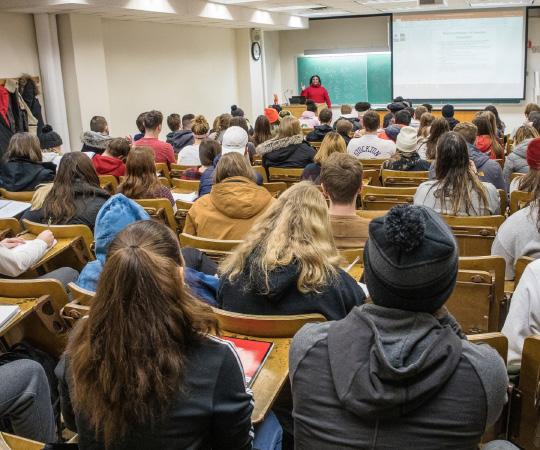
We have grown up in an era of technological growth unparalleled in human history. In 1987, just 35 years ago, Microsoft revolutionized the computer industry by releasing Excel — a software program that allowed users to manage neat rows and columns and computerized personal finance. This year, they invested in a technology that scored 90% on a Wharton business school exam.
It feels impossible to predict where the next twenty years will go or what the economy could possibly look like in the future.
And that’s the case for a humanities major. On one hand, we have been told that our experience in the workforce will be radically different from 40 years at an IBM desk job, a 401k and retirement. On the other hand, we have become convinced that specialization is the key to success. If you want to do business, study business. If you want to be a journalist, study journalism. If you’re not quite sure, try out STEM and you’ll make a lot of money as an engineer or specialist.
The argument against the humanities major is that it is hard to get a high paying job
directly after college, a major concern to students swamped with debt and uncertainty. But, as Amanda Ruggieri points out for the BBC, “Our assumptions about the market value of certain degrees — and the ‘worthlessness’ of others — might be off.”
Students with humanities degrees assimilate to the upper echelon of diverse fields — from management, to business, to science. So why the continuing stigma against the field?
In his March article, “The End of the English Major,” Nathan Heller recounts a conversation he had with a Harvard student about “whether there seemed to be a dominant vernacular” on campus. The student replied that there was one: “the language of statistics.”
Heller remarks that the student seemed to be correct: “Statistics [are] now everywhere, our language for exchanging knowledge.”
The quantitative methods of data, sample size and confidence intervals have made abstract and theoretical arguments irrelevant in the eyes of many professionals. More data, science and technology have become our leaders’ prescription to the many ails society faces.
And, over time, the humanities have been caught in the middle. An art history major was reduced to a punchline by President Barack Obama as he pushed for more STEM education. The United Kingdom’s focus on science and math has led to a 20% drop in students taking A-level English classes.
But, if data is to rule the 21st century, it seems likely that the
skills future and current society are most likely to value is the ability to derive meaning from that information, the ability to contextualize numbers and the ability to present them in a way that compels humans. These skills are the “soft skills” that every employer yearns for and the skills a humanities major prioritizes.
It is important to remember this single-track method to higher education is a new one, and many of the greatest pioneers in science, technology and business have linked their success to the interdisciplinary knowledge a humanities degree o ers.
Steve Jobs said the most important class he ever took in college had nothing to do with computers — it was a calligraphy course. Recalling the event in his 2005 commencement speech at Stanford, he cited the class as a major influence to the word processing programs that would define the early iterations of Macintosh.
“I learned about serif and sans serif typefaces, about varying the amount of space between di erent letter combinations, about what makes great typography great,” Jobs said. “It was beautiful, historical, artistically subtle in a way that science can’t capture, and I found it fascinating.”
In a 1996 article for the Harvard Business Review, Bill Gates attributed a similar understanding of subtlety to Warren Bu ett’s success.
“Being good with numbers doesn’t necessarily correlate with being a good investor,” Gates writes. “Warren doesn’t outperform other investors because he computes odds better. That’s not it at all. Warren
never makes an investment where the di erence between doing it and not doing it relies on the second digit of computation. He doesn’t invest — take a swing of the bat — unless the opportunity appears unbelievably good.”
Again, these skills are soft skills — interpreting meaning and applying theories rather than just plugging values into preexisting formulas. But, in the 21st century, the decline of the humanities for the benefit of STEM has damaged the pursuit of holistic knowledge; the kind of knowledge that allows you to make the interdisciplinary connections necessary to becoming the next Steve Jobs or Warren Bu ett.
Before considering your major, consider what you want your education to mean and what you are looking to get out of it. This is a hard question to answer, and it is one that will almost certainly change over your time on campus. But it is
an important one to grapple with if you want to make the most of your four years and acquire the knowledge necessary to compete in the future American economy.
Above all else, remember there is no right track to success. What success looks like today or twenty years ago may look very di erent from what it looks like tomorrow. Learning for the sake of learning should be the goal of any education, and it is the promise of this university.
Don’t ignore the seemingly benign influence of the humanities. Use the knowledge they provide as another tool in your ever-expanding toolbelt.
Graham Brown is an Opinion Editor and Editorial Board Member. He is a junior studying political science and english. Do you agree that humanities majors are an undervalued option? Send all comments to opinion@dailycardinal.com
Congress shall make no law respecting an estab lishment of religion, or prohibiting the free exer cise thereof; or abridging the freedom of speech, or of the press; or the right of the people peaceably to assemble, and to petition the Government for a redress of grievances. Congress shall make no law respecting an establishment of religion, or prohibiting the free exercise thereof; or abridg ing the freedom of speech, or of the press; or the right of the people peaceably to assemble, and to petition the Government for a redress of
A conundrum emerged across UW System campuses following the release of the Student Views on Freedom of Speech survey conducted in the fall of 2022.
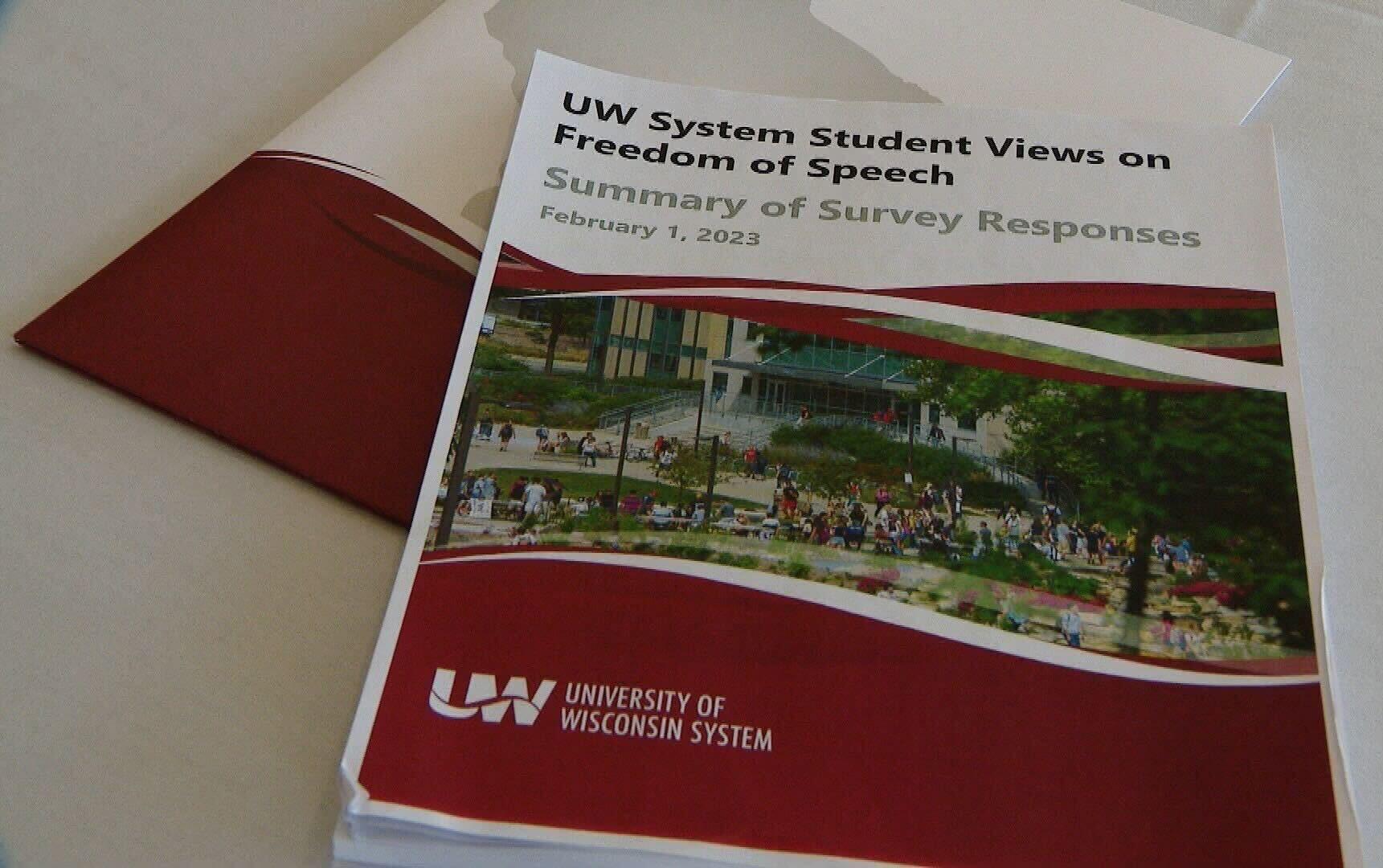
In early April, Dr. Jacqueline Pfe er Merrill, director of the Campus Free Expression task force at the Bipartisan Policy Center (BPC), urged members of the Wisconsin Assembly Committee on Colleges and Universities to consider the concern of free speech across college campuses.

E orts by UW campuses to address free expression on college campuses have been marked by turbulent attempts to
reconcile the emotional impact unrestricted speech, including hate speech, can have on students while attempting to uphold legal principles of the First Amendment.
At UW-Madison, for example, Chancellor Jennifer Mnookin and other campus leaders have faced challenges ensuring a welcoming campus for all students.
The presence of antisemitic gra ti and chalkings at UW-Madison during the first day of classes in fall of 2022 created student unease, something Mnookin acknowledged during a meeting last November with student media.
Still, she contended that the First Amendment — and all of its protections — applies directly to UW-Madison as it is a
on a controversial topic in class, compared to 42% and 35% of “very conservative” and “somewhat conservative” students, respectively.
Across various topics, Sheil said only 1 in 10 students reported they would be “extremely likely” to consider viewpoints they disagreed with.
Conservative students were more likely to perceive a negative response while speaking in class, according to the survey.
But just 10% of students reported experiencing social consequences for speaking up about a topic. The nature of these consequences were not explored, according to Sheil.
“The further right, the more trends showed up — feeling like they would self-censor more, feeling like they might be being pressured to a point of view by the professor,” Sheil added. “These trends are showing up in virtually all these surveys being done by lots of di erent organizations.”
Merrill felt campuses should be a place where conservative students have conservative faculty in leadership roles.
“There’s a real social consequence of being a self-identified conservative — how we think about that with peers, and addressing that with peers is a tough question,” Merrill said.
But Rep. Jodi Emerson, D-Eau Claire, disagreed with the Republican stance on self-censoring, sharing other reasons for its occurrence such as personal awareness and introversion.
“Self-censoring isn’t not having free speech and free expression. Self censoring, in my mind, is when you realize that other people have di erent viewpoints and you want to stop and think about how [your] comments are going to be received by this other person,” she said.
When the Wisconsin Assembly held its first discussion about the free speech survey results since they were published during a Committee on Colleges and Universities meeting in April, committee members attempted to merge expertise from Merrill’s task force with UW System survey results to aid campus expression.
“I have heard commentary over the last several years, including from my own recent employer, that some Gen Zers are coming in and have a lack of tolerance for di erent viewpoints,” Rep. Amanda Nedweski, R-Kenosha, said. Committee chairman Rep. Dave Murphy, R-Appleton, further emphasized how nationwide student speech surveys and publicized events “highlighted a national trend towards the suppression of free speech.”
At the hearing, Merill emphasized four key takeaways her task force constructed to help universities facilitate freedom of expression. Although Merrill’s team found free expression is a “threatened value” at UW System campuses, system leaders had taken steps to foster a culture of free expression through curriculum and strengthen policies on academic freedom.
trination.”
DEI programs are in place to produce a safe environment for marginalized communities and expand enrollment demographics, according to UW-Madison’s diversity, equity and inclusion website.
In response to the video, one student said the racist language was “not just words,” but “a fucking threat.”
UW System President Jay Rothman told the Milwaukee Journal Sentinel in May that DEI o ces are crucial to progressing students’ interaction in a diverse workforce as well as improving retention and graduation rates.
The Assembly Committee on Colleges and Universities has not had a conversation on the circulated video of a UW-Madison student expressing racist language as of early June, according to Emerson.
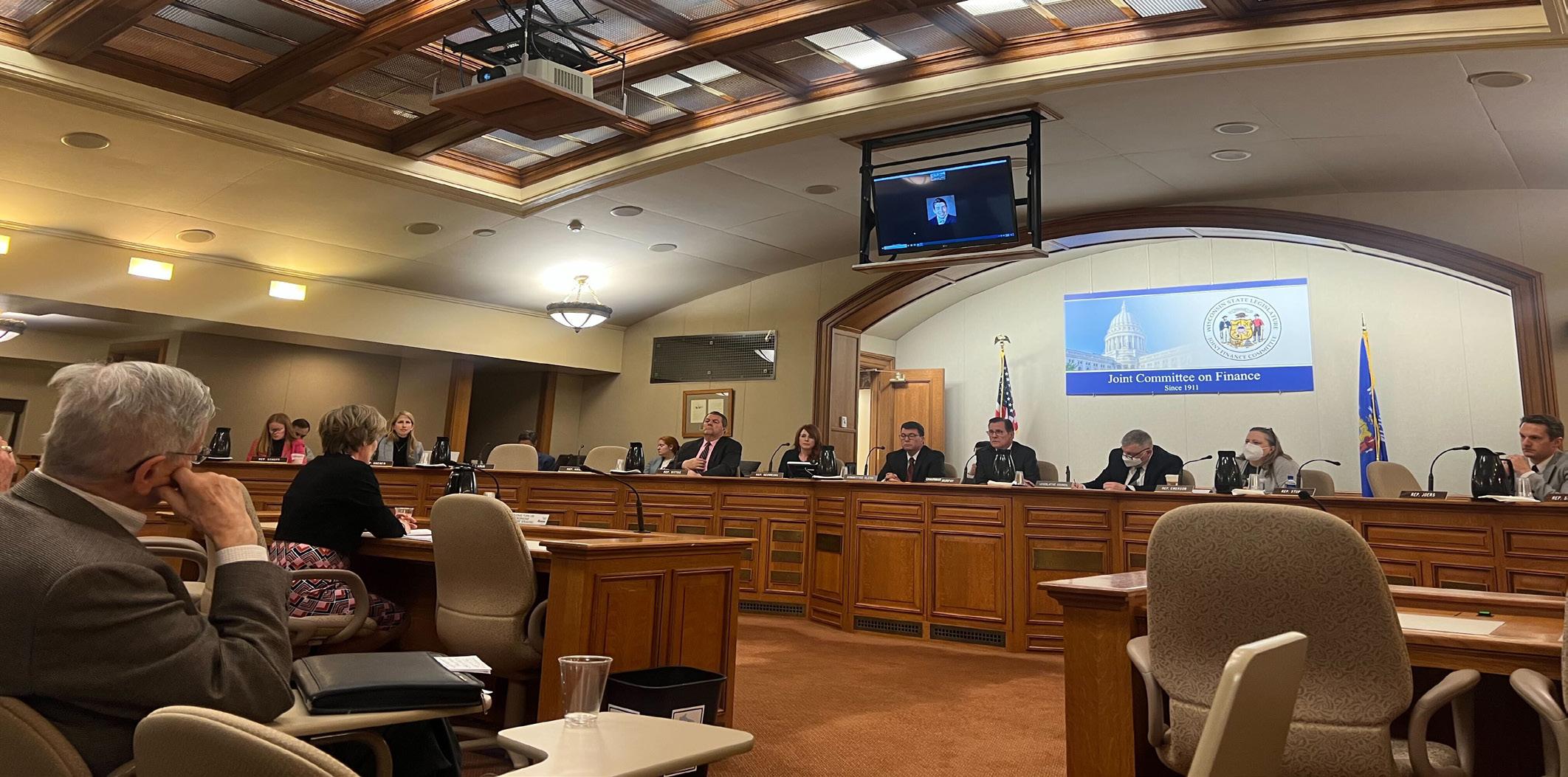
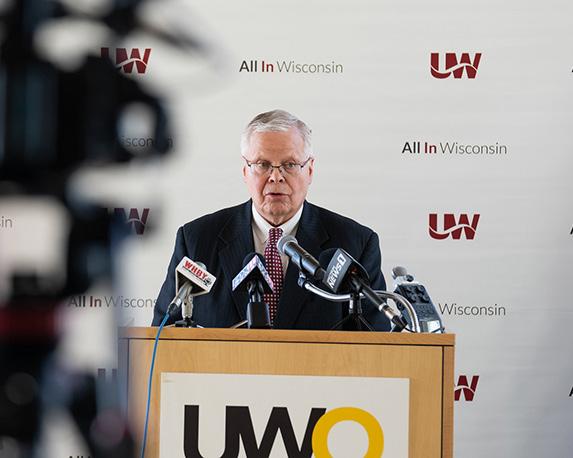
“I don’t think that the committee really should get involved in some of that stu , because then we get to the point where we’re micromanaging something that’s [for] individual campuses, Emerson said. “That’s why we put people in charge.”
Emerson agreed with UW-Madison students that the video was “absolutely abhorrent.”
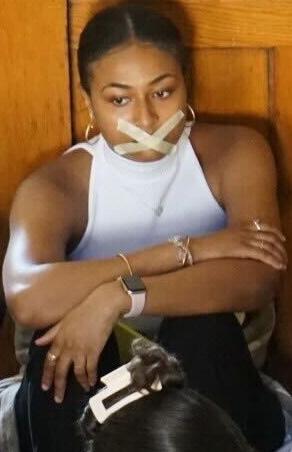
“When [she] said I’m going to hunt them down, that seems like dangerous rhetoric to me,” she added.
was protected, Sheil said.
“I was very surprised to see hundreds of students reporting institutional consequences for their expression,” he said. “One of the things [UW system is] supposed to provide [in] that report is whether there were any frequent violations or free speech discipline. Nobody ever reports any,” he added.
UW campuses have created their own projects to break down free speech barriers. UW-Eau Claire has held freedom of speech workshops on campus so students are knowledgeable about their First Amendment rights and can voice their opinions responsibly.
Some workshops are full-day a airs while others may last a few hours in the evening, according to an email statement from Eric Kasper, one of the UW-Stout faculty members who worked on the free speech survey.
public university.
“One person’s hate speech is another person’s idea,” Mnookin explained, asserting the administration was not trying to “change anyone’s mind” but rather “help students understand they can learn from people who they disagree with.”
And in early May, a video circulated of a UW-Madison student saying racial slurs and violent remarks directed at Black people. This led to peaceful student demonstrations and town halls hosted across campus, including an Associated Students of Madison (ASM) forum where students shared dissatisfaction with the university’s response to the video.
Timothy Sheil, a professor of English, philosophy and communication studies at UW-Stout, has been involved in free speech work on college campuses since the 1990s. He read the Bipartisan Policy Center’s 2021 report, which recommended collecting college data on free speech, he told The Daily Cardinal.
In January, Sheil contacted UW-Stout faculty April Blusky Buczek and Eric Kasper to initiate the Student Views on Freedom of Speech survey across all 13 UW campuses to identify how student experiences with free expression influence self-censorship or classroom discussions. The survey was distributed late last year after student and faculty concerns stymied its initial planned rollout in April 2022.
The survey found 92% of students expressed their unfiltered views on a “controversial topic” because they knew enough about the topic. Similarly, 91% of students said it is because they cared about it or were encouraged to speak.
“Students reported the vast majority of their professors who teach controversial material are encouraging students to be involved in conversation and presenting di erent viewpoints,” Sheil said.

Still, the study found a significant gap in student perceptions of how welcome their opinions are in the classroom or other settings. A majority of “very liberal” (64%) and “somewhat liberal” (51%) students reported expressing their views
Merrill and the representatives said freedom of expression must be advocated for all students with varying political ideologies by implementing more conservative faculty.
“There’s a limited pipeline of conservative professors,” Merrill explained. “I do think there are ways of doing more. To me, nobody should be hired [for their] political viewpoint.”
Emerson, who sits on the Assembly Committee on Colleges and Universities, disagreed. From her perspective, the issue isn’t that UW System campuses were excluding conservative student and faculty viewpoints— rather, she felt universities attracted a more left-leaning demographic brought up to prioritize higher education.
“People who are in the military tend to vote on the right side of the political ideology. Does that mean our military is indoctrinating them to be conservative? Or is it that the type of people who go into the military,” Emerson told The Daily Cardinal.
UW campuses have become hotbeds for free speech skirmishes as debates over identity, belonging and expression play out in surveys and committees.
Stando s were particularly volatile at UW-Madison, where visits from high-profile conservative speakers Matt Walsh and Ted Cruz provoked fierce responses from students who said their presence — in Walsh’s case, the presence of a selfdescribed “theocratic fascist” — emboldens hateful rhetoric on campus.
Arguably the most notable incident to date occurred in early May, when a video of a UW-Madison student saying racial slurs and violent remarks directed toward Black people circulated.
The video provoked widespread outrage from students, faculty and sta including a demonstration where over 200 students peacefully marched across campus and presented Mnookin with a list of nine demands for university leaders.
Days after the video began circulating, Assembly Speaker Robin Vos announced his intention to eliminate diversity, equity and inclusion (DEI) o cers at UW System campuses, stating universities have transformed into “institutes of indoc-
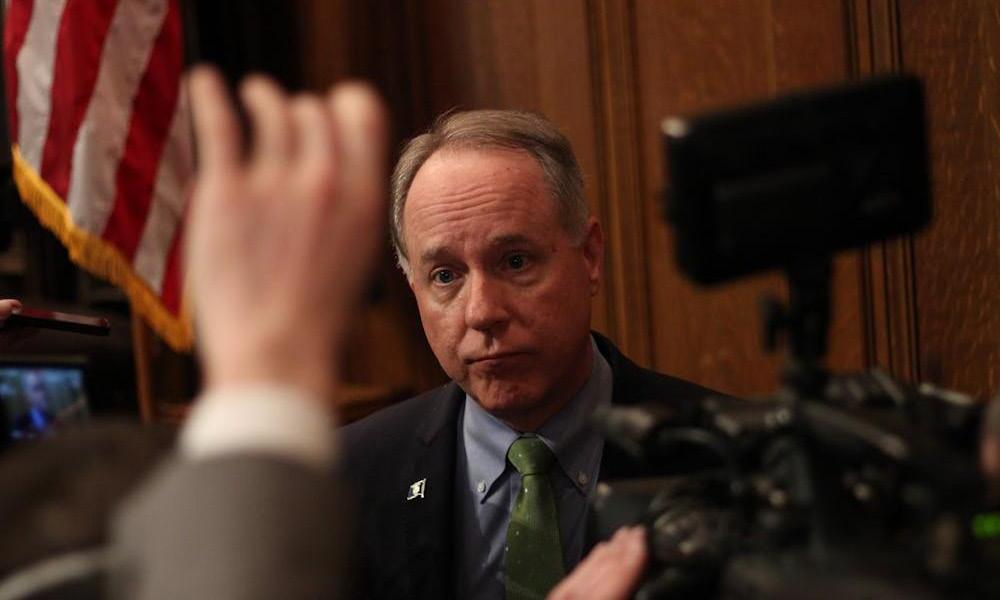
But Emerson was hesitant to say the student’s comments warranted expulsion, an action constitutional law experts and university o cials maintain is not allowed under legal precedents governing free speech. A statement UW-Madison published in May said the school cannot restrict students and employees from posting to personal social media accounts, nor can they penalize such posts.
“Saying the n-word is despicable, but allowable,” Emerson said. “I don’t know if I want to be in a country where we’re micromanaging what comes out of everybody’s mouth. That’s [why] we need to defend everybody’s right to say horrible, terrible things.”
The UW System plans to launch the Wisconsin Institute for Citizenship and Civil Dialogue (WICCD), Rothman announced last November. It will be a system sta ed o ce with resources for all 13 campuses to learn how to encourage students participation in discussions and opposing views, according to Sheil.
“Maybe somebody at Oshkosh is doing something great and we just don’t know about it. Let’s find out, let’s share that with the other campuses, and they can benefit from whatever that happens to be,” he said.
The UW System survey team recommended Assembly committee members develop methods for students to comfortably contribute any ideology in classroom discussions during an informational hearing in Eau Claire in April, according to Sheil.
Sheil emphasized that, at a public university, faculty cannot shut speakers or professors down. “We’ve got to use our own speech to combat their speech,” he said.
Additionally, Sheil told the Cardinal annual reports provided by the 13 campuses to the UW System do not indicate the campuses are imposing any “institutional consequences” despite more than a hundred students expressing they received an institutional consequence for constitutionally protected expression.

Regent Policy Document 4-21 requires annual campus reports to the UW System. UWSA then compiles the campus reports to the Board of Regents, according to Sheil. Students have the ability to file a bias incident report to a free speech committee run by the Board of Regents, according to RPD 4-21. The committee will do a “fact-checking” and see if their speech
“Most of them are open to all students, but we also have one type of workshop designed just for student government members. The general workshops involve some faculty instruction on the First Amendment, followed by students breaking into groups to discuss hypothetical situations,” the statement read.
Some of these hypotheticals include situations in which a public university punished or sanctioned someone for their opinion. Students then have to decide if the university’s response violated the First Amendment, according to Kasper. Workshops for student government are focused on relevant decision-making, such as the allocation of student segregated fees, Kasper said.
In addition to the workshops, UW-Eau Claire created a 10-minute video shown to all students at orientation last fall to educate them on freedom of speech. The university also hosted a student reading group each semester, including books such as The Fight for Free Speech and Free Speech on Campus.
Sheil said campuses need the time and resources to take steps to address issues with the protection of free expression. It’s a long-term project that may require multiple years of work to reveal di cult conversations, he added.
“This is part of campus expectation. This is part of the value of the degree you’re going to get,” Steil said. “You might be becoming an engineer, but it’s still really important for you to understand how to have productive — not destruc tive — conversations with people you disagree with.”
As free speech and inclusivity concerns grow at UW campuses, leaders navigate legal, political barriers in search of solutions
The University of WisconsinMadison has plenty to brag about. From its consistent academic prestige to its beautiful lakeshore campus and buzzing social scene, UW-Madison is considered by many a top university in the nation. However, another attribute that garners national respect is Wisconsin’s long and storied athletic programs — specifically in football and men’s basketball.
When thinking of UW-Madison, you may picture those classic Saturdays revolving around Badger football. Mornings are set aside for tailgating and afternoons or evenings are spent at historic Camp Randall Stadium, taking in the fall Wisconsin weather and perhaps a Badger victory.
Or, maybe you think of those magical Big Ten and NCAA Tournament runs mounted by the men’s basketball team, with their seemingly annual late-season heroics signifying an end to another chilling Wisconsin winter.
Unfortunately, some of that luster was absent this past season. After decades of remarkable success in both sports, Wisconsin’s latest seasons in both football and men’s basketball proved to be uncharacteristically disappointing. In what may be the worst combined sports season in almost thirty years, the football team finished the season 7-6, winning the measly Guaranteed Rate Bowl. The men’s basketball team went 17-14 and failed to qualify for the NCAA Tournament.
I’d be lying if I said the football and basketball seasons weren’t some of the things I was looking forward to the most ahead of my freshman year at UW. As a lifelong Badger fan, my expectations tend to be high, but the anticipation of success was valid coming into this year’s football season.
Wisconsin football was ranked #18 in the 2022 AP Preseason Poll. Perhaps visions of an undefeated season would have been a bit much, but expecting to compete for the Big Ten title was certainly reasonable.
After starting the football season o with a bang by blasting Illinois State 38-0 in the season opener, Wisconsin’s hopes of a dominant defense and potent rushing attack were seemingly confirmed, albeit against a lower-tier Football Championship Subdivision (FCS) opponent.
It only took one week for the expectations of fans across the state to take a major hit, as Wisconsin’s 17-14 home loss to Washington State in Week 2 was uninspiring to say the least. Wisconsin’s typically lethal running game and quarterback Graham Mertz combined for only 14 points against the Cougars, a middling Pac-12 team. In the wake of such an alarming loss, much of the excitement for Wisconsin’s 2022 season was put on hold.
As the season went on, gameday excitement throughout Madison dwindled by the week. In Week 4, third-ranked Ohio State bludgeoned Wisconsin on the road in the Big Ten opener, 52-21. The Badgers came in as heavy underdogs and were immediately reminded why after Ohio State established dominance and scored touchdowns on each of their first four possessions. The game was practically over as soon as it started after Ohio State jumped out to a 21-0 first quarter lead.
Falling to Ohio State — a behemoth of the college football world and longtime feared Big Ten foe — is one thing. But losing in such embarrassing fashion was something worse. This was the epitome of ugly.
Things only got more miserable a week later. Welcoming back former coach Bret Bielema and the Illinois Fighting Illini to Camp Randall, Wisconsin fans expected to get back on track after the disaster that occurred in Columbus a week before.
Linebacker Nick Herbig even took to Twitter to display his confidence, telling critics, “Keep that same energy,” after a presumed bounce back against Illinois, assumingly referring to the negative energy directed towards the team following the Ohio State loss.
Though the opponent was di erent, similar nightmares continued into another Saturday, where they were met with a rude awakening from their longtime little brothers to the south.
If you thought the Ohio State game left a bad taste, the loss to Illinois stung even more. Losing at home on a picturesque fall day is never fun, but it’s flat out embarrassing when it’s a 34-10 blowout at the hands of Illinois.
Standing in the student section that day, I couldn’t help but feel a little let down. Of course, gameday in Madison can be a blast for any student, but sweet victory makes it undoubtedly better. Where was the winning? I expected to be a part of a winning culture. Instead, here we were, losing to the perennial punching bag of the Big Ten.
Chris McIntosh, Wisconsin’s athletic director, had similar feelings. The day after losing to Illinois, he fired longtime head coach Paul Chryst in a program-altering decision.
Anyone following Wisconsin football realized that this season was uncharacteristic for the Badgers. But few, including myself, expected such drastic changes to be made so suddenly.
Chryst, a UW alum in the midst of his eighth season as head coach, had served as the model of consistency, accumulating a 67-26 record with the Badgers. A record of 43-18 in Big Ten play was good for three Big Ten West championships and six bowl wins. However, after eight seasons of not being able to get over the hump, such lackluster performances called for a changing of the guard. The decision to cut ties with Chryst signaled Wisconsin’s urgency to right the ship.
McIntosh appointed longtime
defensive coordinator Jim Leonhard as interim head coach, and the Badgers went on to win three out of their next four games — beating Northwestern, Purdue and Maryland. Unfortunately, late season losses in Iowa and against Minnesota put a damper on the ending to Wisconsin’s 2022 campaign.
While Leonhard did what he could to right the ship, Wisconsin was still left with an ugly 6-6 record and their heads hung low heading into the o season. Aside from the COVIDshortened 2020 season, this was the first time Wisconsin finished the regular season without a winning record since 2001.
Coming into the season, the Badgers expected to compete for the Big Ten title. Instead, they finished in the bottom half of their division with a losing record in conference play. A disappointing season, to say the least.
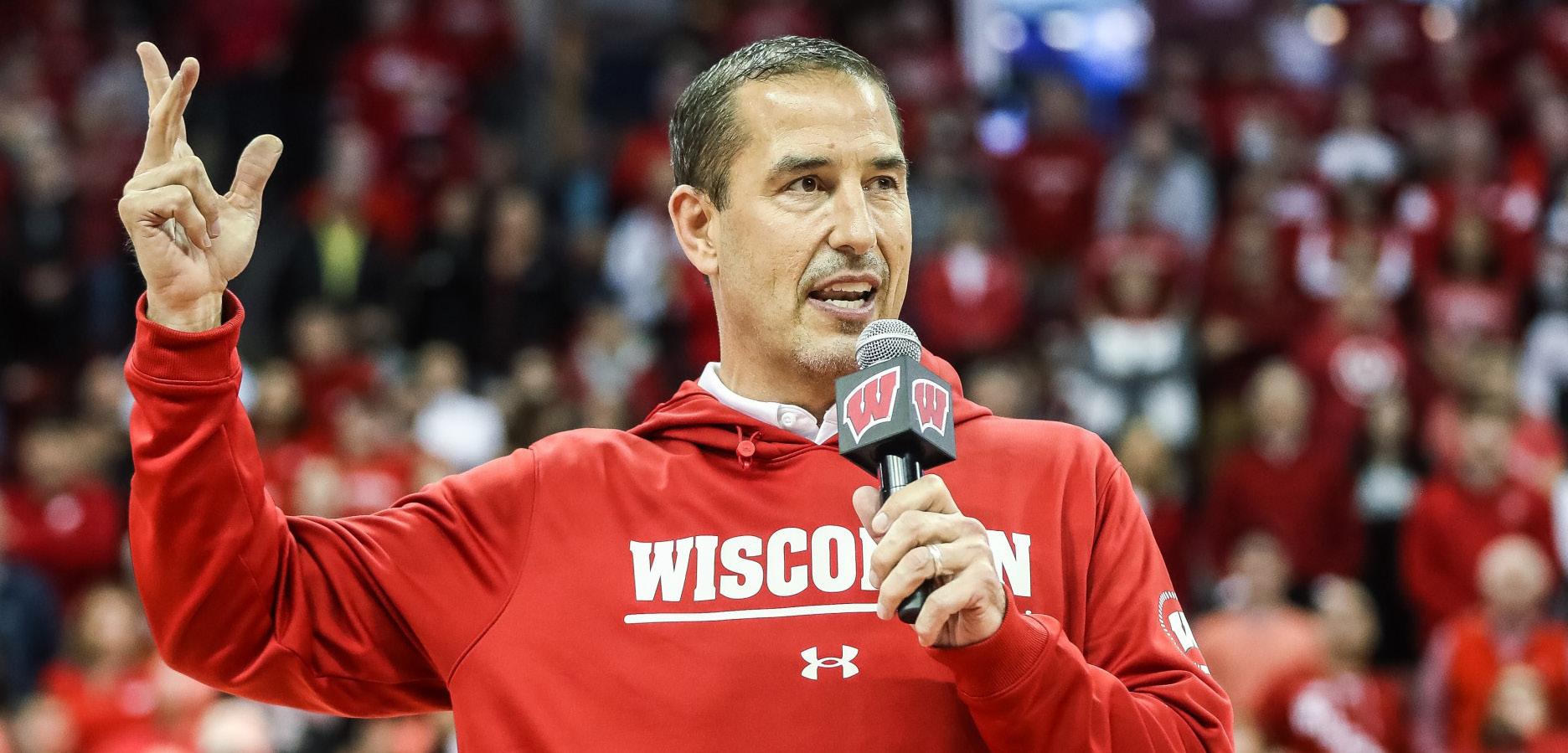
Following a challenging football season, at least there was still the fun of basketball season to look forward to. While some may consider football the main show in Madison, the consistent success of head coach Greg Gard’s teams — and Bo Ryan’s before him — kept Wisconsin relevant in the men’s college basketball world.
Many picked Wisconsin to finish in the middle to bottom of the Big Ten, but heading into the season an NCAA Tournament appearance seemed more than feasible. Even if national pundits weren’t expecting much from Wisconsin, fans had grown accustomed to seeing the basketball program outplay expectations.
By January, it looked as though Wisconsin was well on its way to exceeding expectations. The team was 11-2 and had already beaten four future NCAA Tournament teams. The Badgers started o the season unranked but climbed up to #14 in the AP Poll. It looked like the Badgers were in the midst of another successful season.
Then, between Jan. 7 and 28, Wisconsin lost six out of seven games and completely flipped the script on the season. It started with Tyler Wahl’s ankle injury on Jan. 3 against Minnesota. From there, Wisconsin was forced to play without their leading scorer for three games. And by the time Wahl was able to return on Jan. 17, he was a shell of his former self. In just seven games, Wisconsin’s season went from surprisingly promising to extremely alarming.
Wisconsin’s early-season confidence was swiftly replaced with
especially this past year — the performance in football and men’s basketball was unquestionably below usual standards. But, for as di cult as the last twelve months were for Wisconsin football and men’s basketball, the future is expected to look di erent.
A highly anticipated new era of football in Madison begins with the arrival of new head coach Luke Fickell and company. With a refreshing new leader and “new-look” o ense helmed by new o ensive coordinator Phil Longo, excitement for Wisconsin football has arguably never been stronger, making it much easier to forget about the struggles of last season.
inconsistency that plagued the rest of the season. Without Wahl, Wisconsin’s flaws were put on full display. Going home for winter break in late December, Wisconsin basketball looked to be in a positive position. But upon returning a month later, the Badgers seemed trapped in a dark hole with no one knowing when or if they would be able to climb out.
The rest of the season was mired with similar inconsistency. Throughout February, Wisconsin proved capable of winning with key wins against conference opponents. However, sandwiched between those victories were some extremely disheartening losses.
After showing some heart with a 65-60 road win in Columbus on Feb. 2, Wisconsin responded by scoring just 52 points in an ugly home loss to a feisty Northwestern squad.
The next week, Wisconsin battled its way to a gritty overtime win against Penn State, only to falter to Nebraska in a must-win game. Three days later, they beat Michigan 64-59 at a packed Kohl Center.
From a fan’s perspective, watching the Badgers in February can be summed up by the famous Michael Corleone line in Godfather III: “Just when I thought I was out, they pull me back in.”
It was truly maddening. Fans knew what the Badgers were capable of as they’d shown their ability to beat good teams in close games, but Wisconsin’s lack of consistency sank their season.
A blowout loss to Ohio State in the opening round of the Big Ten Tournament ultimately did Wisconsin in, dashing what little hopes were left of reaching the NCAA Tournament. While the Badgers weren’t expected to seriously compete for a Big Ten title, the norm for the program is, at the very least, an NCAA Tournament appearance. Before this season, Wisconsin had only missed the NCAA Tournament once this century, so an absence was extremely disappointing.
There is no doubt Wisconsin’s recent football and basketball seasons have been nothing short of disappointing. A six-win football season and missing out on the NCAA Tournament in basketball are disappointing enough results on their own, but for both to happen in the same year? That rarely happens at Wisconsin, causing major upheavals within the athletic programs.
The pride behind the programs never waned, but in recent seasons —
And in basketball, a season of growing pains seems to be out of the way. As the Badgers struggled through a frustrating year, they gained experience. With the return of all the main pieces — plus an intriguing freshman class — a return to winning ways is expected.
While the past year of Wisconsin football and basketball was in no way pretty, the future in Madison is bound to be bright.
Last season’s expectations:
Historically an impressive volleyball team, the Badgers were expected to do well last season. The volleyball team consistently posts winning records and deep runs in the Big Ten Championship, NCAA Tournament and National Championship. Wisconsin fans were in for an exciting season.
Last season’s reality:
The volleyball squad is always a fun Wisconsin team to watch, and this season was no exception. The Badgers made their 10th-straight NCAA Tournament appearance. Unfortunately for Badger fans, they lost in the Regional Finals to Pittsburgh. Nonetheless, they won their ninth overall Big Ten Championship, notching their fourth straight Big Ten title. These Badgers demonstrate the pinnacle characteristics of a team: unity, trust and ferocity.
To find out about this season’s expectations for the volleyball team as well as all other athletics’ outlooks for the upcoming seasons, head over to dailycardinal.com.

The Wisconsin Union Directorate (WUD) hosted a screening Monday evening of the critically acclaimed 2019 film “Booksmart,” directed by Olivia Wilde, on the iconic Memorial Union Terrace.
“Booksmart” is the latest in the WUD Film Committee’s ongoing “Lakeside Cinema” series, which will bring a variety of crowd-pleasing films to the Memorial Union Terrace each Monday this summer.
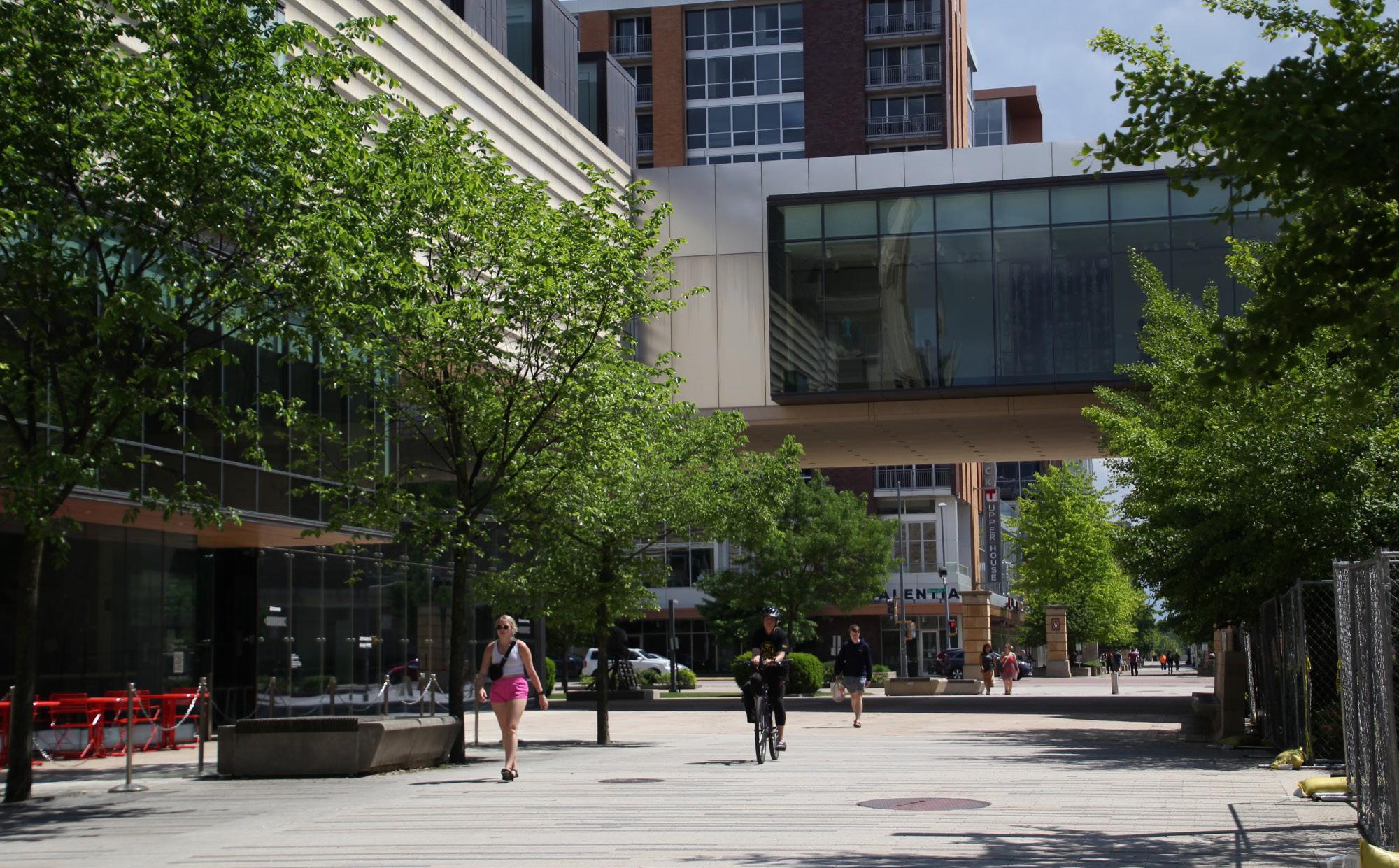
“Booksmart” is the second film to be screened so far and the first of two films chosen to honor Pride month alongside the 1999 cult classic “But I’m A Cheerleader.” Other movies scheduled for the 2023 season include “Black Panther,” “High School Musical 2” and “The Big Lebowski.”
I attended Monday’s screening to give you a glimpse of what to expect from summer films at the terrace.
I arrived at the Memorial Union Terrace well in advance of the “Booksmart” screening, which was a wise choice. Like most nights during the summer, the Terrace buzzed with the sounds of chatter, laughter and pitcher clatter. Though there were plenty of tables available at the Terrace, not all had a good view of the screen, and most which did had already been taken by the time I arrived. I was lucky to stake out a decent spot.
Regardless, there was an easygoing revelry to the event. Everyone was in good spirits, and most were probably drinking them too. Food and drink are within easy reach at the Union, even if on the pricier side.
The weather was superb for a day on the Terrace. Cool air rolled off the lake—which was beautiful as ever—tempering the summer heat. As the sun set, the rippling water turned to copper; a truly picturesque locale for a film screening. Belly full and lulled by the pleasant chatter of a busy Terrace, I couldn’t help but feel at ease —
perfectly primed to sit back and enjoy a film.
I knew little about “Booksmart” going in, aside from the fact that it and last year’s “Don’t Worry Darling” were both directed by Olivia Wilde. I was pleasantly surprised to find the film to be quite funny and charming, even if it was yet another in a long line of coming-of-age stories.
The reveal near the beginning of the movie — wherein the two overachieving leads, Amy (Beanie Feldstein) and Molly (Kaitlyn Dever), discover that their peers got into top colleg-
es despite also partying on the weekends — was a clever and hilarious twist on a classic high school trope.
While the lake served as a picturesque movie backdrop, seeing a film at the Terrace comes with a few hiccups you won’t find at most indoor theaters. For one, the Union is not exactly an environment free of distraction. Although things quieted somewhat once the film began, the normal drone of conversation continued throughout the majority of the movie. It wasn’t too difficult to ignore, but it might become an annoyance to
those who are easily distracted.
Additionally, depending on where you sit, you might find that people are blocking your view of the screen — I myself had trouble reading the subtitles in a few scenes.
Regardless, the picture and sound quality were quite good, and I found myself engrossed in the film anyway. The appeal of the Lakeside Cinema series isn’t that it’s the perfect viewing experience, but that it combines the warmth and cheerfulness of a warm summer evening at the Union with a night at home watching a movie with friends. Perfect isn’t the point.
It would be a lie if I said that I didn’t have a good time watching “Booksmart” at the Union this past Monday. The film wasn’t on my radar prior to the event, but I’m glad to have seen it.
The age of streaming has given us near-unlimited choice in what to watch. But one small pleasure which has become elusive since the days of Blockbuster is the delight of taking a chance on a film you haven’t heard of and hasn’t been hand-picked by an algorithm.
Consider taking a chance on one of the WUD Film Committee’s Lakeside Cinema screenings, especially if they’re showing something you aren’t familiar with. Even if the film isn’t up your alley, you’re guaranteed a fun and relaxing evening on the Memorial Union Terrace.
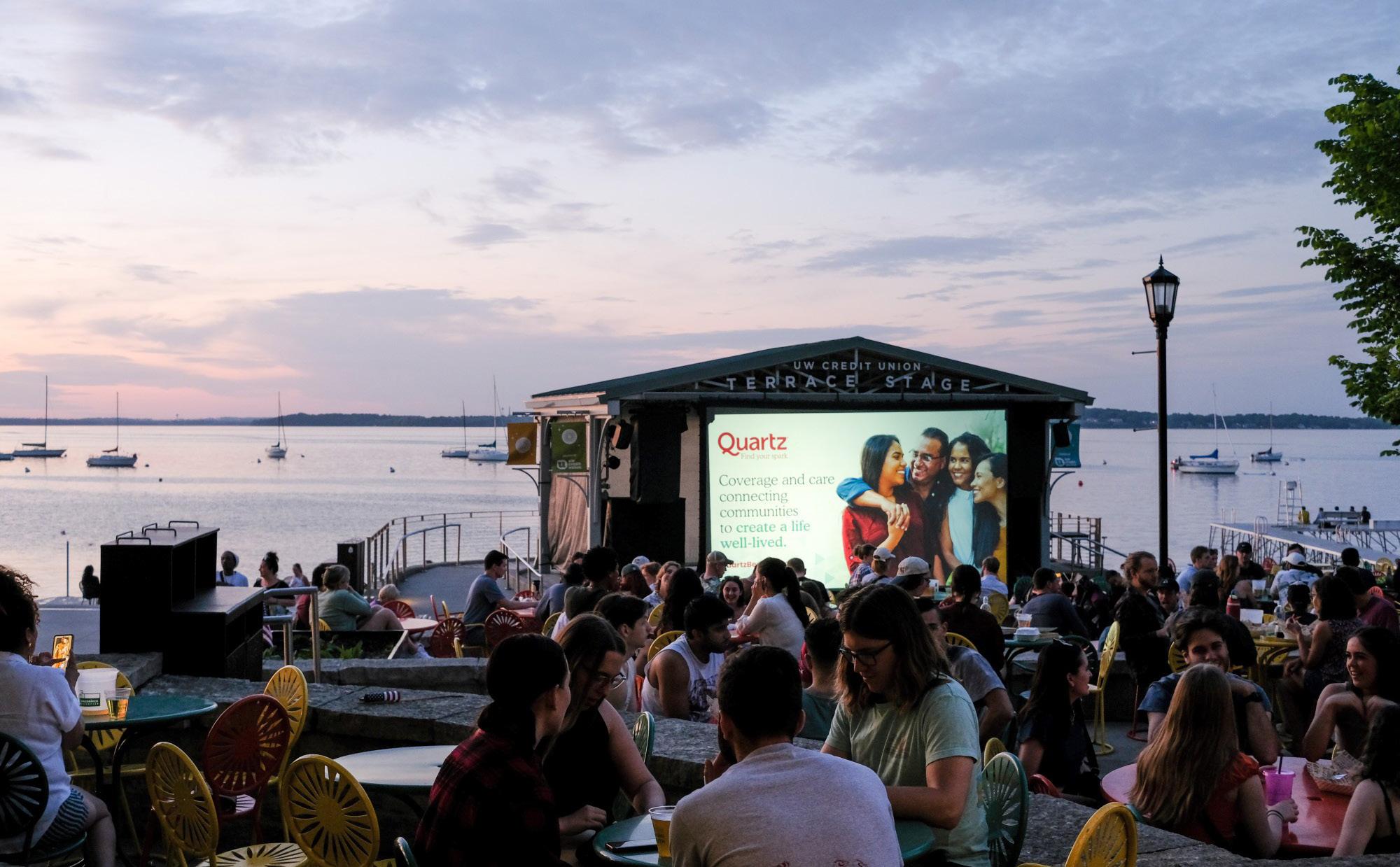
The very title of Monty Little’s exhibition on the second floor of the Chazen Museum of Art — “Premonitions” — eerily retrospects a native identity still unravaged by European colonialism and genocide. The installation’s first half, at least, implicates and convicts the familiar iconography of American history. Monotypes of presidents look less like decorated portraits than a lacerated series of charcoalsmothered caricatures. A long scroll drapes from a wall in the center of the gallery’s first half, its text a continuous stream of ratified treaties between various Indigenous groups and the US government.
Monty Little uses the word “reminder” in the exhibition statement to memorialize what American violence has erased. Or perhaps, as Little cites from scholar Gerald Vizenor’s book “Manifest Manners: Narratives on Postindian Survivance,” to commemorate the “survivance,” the persisting presence of self that survives mass trauma through narrative and language.
The installation seems as permeated by historicity as
by Little’s own personal life. Little, an artist of Diné heritage hailing from Tuba City, Arizona, seems to draw inspiration from his military experience in the Marine Corps during the Iraq War.
“I am projecting my truths about war onto the canvas,” Little told the War, Literature & the Arts Journal in a 2019 interview. “All the scary thoughts you’ve had are projected on the canvas and you want to erase them. I’ll blur the image and try to hide those truths inside [the] paintings.”
Little’s “Consider This as Memory” series, displayed in the latter half of the installation, distorts and scrambles the Indigenous faces of Edward Curtis’ portraits depicting figures of the 19th-century American West.
“Curtis’s photographs are nostalgic images and present illusions of romanticism,” Little says in the exhibition statement.
The altered portraits are products of old techniques of etching, laser cutting and screen printing to transmute Curtis’s original subjects into unrecognizable patterns. Some faces look like rippling disturbances on water. Others look like shreds of lacerated flesh
beneath metal wires.
The erasure of identity assumes a violent form, which is why Little’s pieces in this installation are themselves blunt and declarative. Little’s “Preliminary Skies” features a wall of gaping jaws strung to long braids of hair cut from Indigenous children. The rows of desks in front of the wall not only illustrate the implicit cultural genocide of
identity through children’s indoctrination into boarding schools but also its transliteration into physical violence as something merely observed and institutionalized.
The pieces in Little’s exhibition are intentionally unsettling yet unambiguous about their remembrance of mass genocide. There is no decorum or diplomatic propriety in Little’s versions of infa-
mous presidential portraits. Lincoln was not a hero, Little seems to declare.
The cracked-open jaws of Indigenous children are, like the distorted photographs of Edward Curtis, a disturbed remainder of violence and a largely erased self.
“Premonitions” will remain open for free viewing in the Chazen Museum of Art until July 9, 2023.
 By Hina Suzuki LIFE & STYLE EDITOR
By Hina Suzuki LIFE & STYLE EDITOR
Publications and research institutions routinely rank the city of Madison high in their United States city rankings. In 2018, National Geographic recognized the city as one of the best small cities. PeopleForBikes ranked it second in its list of best cities for bicycling in 2020. And in 2022, Livability named the city the best place to live.
Adding on to these titles, Madison is often praised as one of the best college towns in the nation. The city was ranked in the top 10 midsize cities in WalletHub’s 2023 Best College Towns & Cities in America list, and Best College Reviews ranked the city third on their list of the 50 Best College Towns in America in 2022.
Location matters when finding the right college as the experience during “the best four years of your life” will be partially shaped by the environment you will be in. Though the criteria for each college town ranking may be di erent, they analyze similar aspects — including academic and professional opportunities, livability and social environment.
So does the city of Madison provide the space and opportunity for students to grow both personally and professionally while being inclusive and accessible?
The heart of Madison is,
By Cindy Chang STAFF WRITERof course, the University of Wisconsin-Madison, an institution founded 175 years ago. Students already have access to countless opportunities for intellectual and personal growth just by being in the classroom. But job and internship opportunities are also at one’s fingertips. And with Madison being the third fastest-growing startup city in the country, the number of ways to explore your interests is only increasing, according to investment company York IE.
Not to mention, Madison is a capital city. Opportunities for political involvement — such as
communicating with local ocials and participating in protests or rallies — are accessible to students.

But, let’s be honest — college is about more than learning, and Badgers are known for being masters of balancing academic and personal life.
State Street — which runs from campus to the Wisconsin State Capitol — is lined with cafes, local businesses, restaurants and bars as well as the Overture Center for the Arts, the Orpheum Theatre and the Madison Museum of Contemporary Art. Every
Saturday during the warm months, the largest produceronly farmers market in the country is held on Capitol Square. And the city’s drink, food and music scene expands outside the campus area, which students can easily explore using Madison Metro buses.
For outdoor-loving students, the city o ers 200 miles of biking and hiking trails, five lakes — two of which are only a few minutes away from campus — and many parks. In fact, a survey by the ACSM American Fitness Index found 95% of residents are within a 10-minute walk to one
of the parks.
But every good thing comes with downsides. For the past few years, UW-Madison students have been facing the increasing cost of housing. Finding an a ordable apartment or a ording high rent prices while being a full-time student can evoke stress and anxiety.
And regarding inclusivity, a lack of diversity exists on campus and throughout the city, with more than 75% of the city’s population being white, according to the U.S. Census Bureau. In May, Assembly Speaker Robin Vos (R-Rochester) suggested potential budget cuts if the UW system does not phase out its diversity, equity and inclusion o ces. Vos’ suggestion was made when a video of a UW-Madison student using racial slurs surfaced.
Living in Madison also means learning how to brave freezing temperatures, heavy snowfall and strong winds while walking to class. Not to mention, the harsh winters last for at least five months.
No college town is perfect. What defines a successful college experience is more than location, but Madison is filled with opportunities that provide life lessons and places where you will make unforgettable memories. The only way of achieving them is to seek those experiences yourself. Once you do, you will find that Madison is the best college town.
One of the most important and daunting pressures bestowed upon college students is choosing a major. Not to scare anyone, but declaring a college major is a decisive step that could change the trajectory of your academic and professional journey.
The great thing about a GPS is that they can help users by determining their current position and o ering a guide to arrive at their destination in a timely manner. No matter who you are, a GPS can make your life easier. I hope this GPS finds you well.
It is easy to fall into the trap of, “I have no idea what I want to do after I graduate,” or to compare yourself to the people around you who know exactly what they want to do, but there are a lot of students who are in the same boat as you.
While everyone is on their own journey to discovering the perfect major, there are a few important steps that can guide you and make the journey less stressful.
The first — and most important — step to deciding on a major is choosing one that you are passionate about, not the one you feel pressured to choose. If you’re lucky enough
to be going into college knowing what you want to do or even just have a general idea, still be sure to do some research and make a plan of the required classes you need while leaving room to take classes that are relevant to what you are interested in.
The world is wide, and there are endless career paths that you can take. It is normal to be indecisive or to change your mind, so don’t limit yourself to one major before
exploring other interests you may have. You will be more prepared to switch majors in the long run, should you make that decision.
Every student hopes to arrive at the right destination — which, in this case, is choosing the perfect major. But it is crucial to remember everyone has their own unique starting point. It is common to feel lost, even if others around you seem to have an easier path to choos-
ing a major.
If you have absolutely no idea what you are interested in studying or have scattered interests, it’s alright to feel confused about what you should pick. Consider choosing a broad major. Exploring a major with variety allows you to discover new passions, and being eager to learn a wide variety of subjects will benefit you in the long run.
If you are stuck asking your-
self, “What do I major in?” because nothing interests you, take some time and explore an assortment of classes your first semester. The interests you uncover when you put yourself out there may surprise you.
The nice thing about being in college is that you are surrounded by so many people who are also trying to learn and figure out their own lives, so talk to the people around you. Whether it is your advisors, friends or your peers in class, spending time learning about other people’s journeys may open your eyes to new perspectives.
Additionally, attending major exploration events may help you choose a major because you could discover things you never would have otherwise thought about. Having an open mind about things may bring you closer to realizing what you really want to pursue.
Although there is no GPS that will seamlessly navigate you to finding the perfect major, learning new things about yourself, your interests and your skills can be extremely gratifying. There is nothing more fulfilling than being able to attend a university like the University of Wisconsin-Madison where there are endless opportunities and a unique path waiting for every student.
ages motivation. In addition, the National Library of Medicine noted introductory math and science courses operating as “gatekeeper courses” can discourage students from continuing to pursue a STEM degree.
Between these issues and class environments — including disinterest, bias and rigor — it’s clear to see the culture of STEM can be less than welcoming.
Emma, a statistics and economics student attending UW-Madison who asked that her last name remain anonymous, said being a STEM student has its “ups and downs,” especially as a woman in the field.
Expanding on issues with gender, Emma said “Also, as a woman, I often feel alienated in STEM spaces. I know — even as a university student — I will be making less money than my male coworkers”.
To battle feelings of discouragement in the classroom, Hossain and Robinson proposed “the U.S. must provide more investment in supporting teacher preparation programs that provide strong content and pedagogical knowledge in STEM subjects” to increase inspiration and scientific literacy among all students.
In a broader outlook, researchers concluded solutions to “the STEM education problem” should be handled in an interdisciplinary manner where learning is grounded in STEM discipline departments as well as social science and liberal arts colleges.
Having a well-rounded educational experience is a common source of motivation for STEM majors at UW-Madison, and it’s one Emma cited as helpful.
By Madelyn Anderson SCIENCE EDITORDuring your freshman year at the University of WisconsinMadison, you’ll likely hear one question repeatedly: which chemistry class are you in?
This introductory course is critical for incoming students, especially those who plan on majoring in science, technology, engineering and math (STEM) fields. The competitive career sector requires an array of challenging classes that often feel distantly related to students’ dream jobs.
So, between the stress of sitting in lectures and studying for exams, how does the future STEM workforce stay motivated?
A new UW-Madison study observed that when students reflect on real-world applications of science, they are more inclined to stay on their career path. To come to this conclusion, researchers surveyed over 2,000 students in an entry-level chemistry class.
The study, which was featured in the Proceedings of the National Academy of Sciences, required students to complete written reflections over the course of the semester. One control group wrote answers exclusively on course learning goals, and one test group related them to the real world, reflecting on how chemistry concepts might be applied to other fields or their personal lives.
While talking with UW-Madison psychology Professor Judith Harackiewicz, the UW-Madison news team found test group participants’ answers ranged from surface level to critical thinking.
Harackiewicz and other study organizers discovered that no matter how much thought went into the applied answers, the act of writing them made a di erence. The UW-Madison news team reported that students who
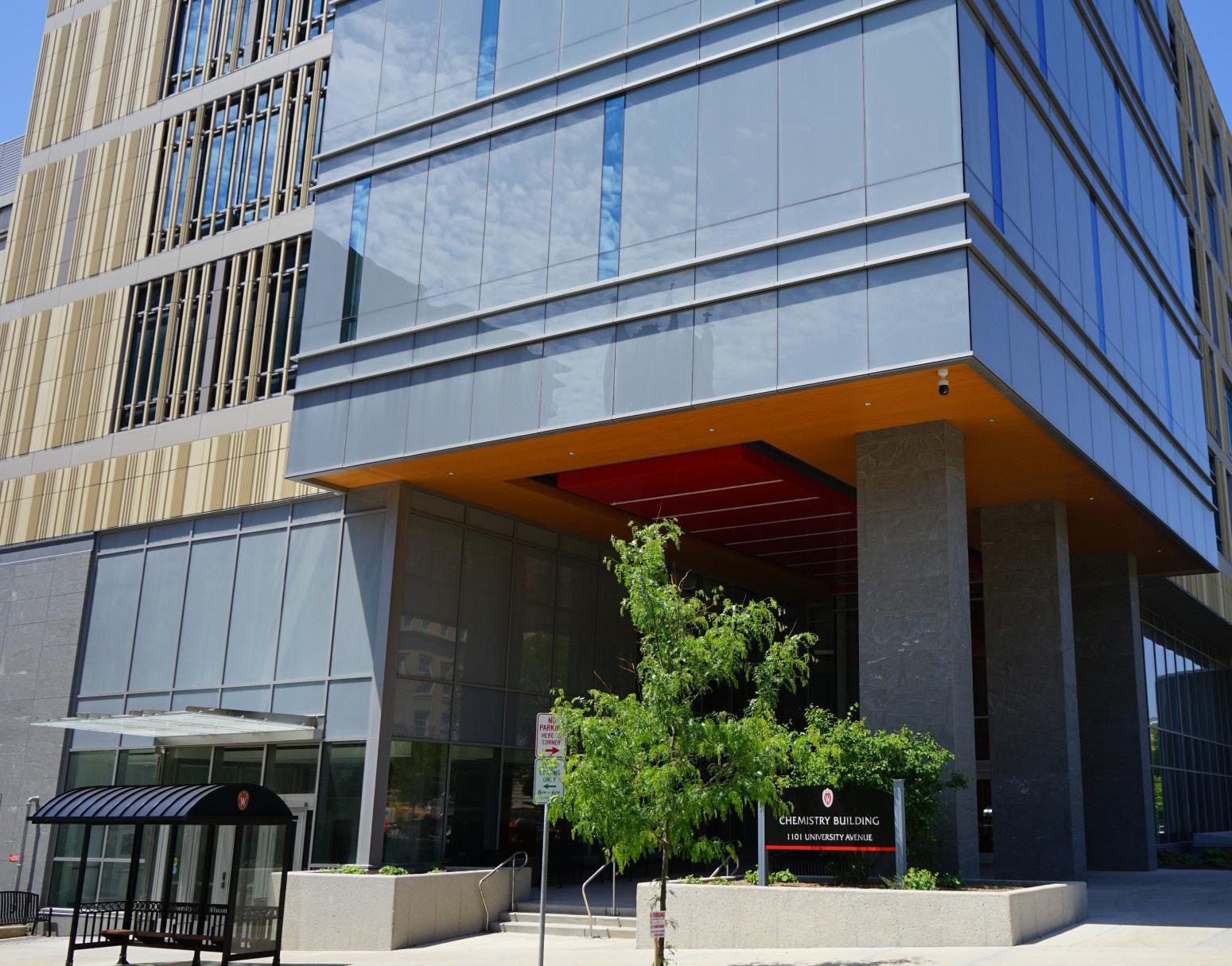
reflected on real-world applications were 4 percentage points more likely to be majoring in a STEM field 2.5 years after the chemistry course (74% vs 70% for the control group).
This data shift was especially prevalent for minority students in STEM fields. These students were 10 percentage points more likely than students who identify with the majority group (14% total) to still be studying STEM 2.5 years after the course (69% versus 55% for the control group).
So, why should people care about this information? For one, it provides evidence for future instructors that cultivating engaging course material matters. The addition of real-world applications on any scale motivates students to keep studying STEM topics.
Secondly, it reveals who benefits from this motivation the most. The positive impact of the written reflections on underrepresented groups in this career sector shows that this may be a key strategy in increasing diversity in STEM fields, a long-term goal of many institutions.
In 2021, the Pew Research Center evaluated future and current STEM workforce demographics. Pew found “Hispanic and Black adults are less likely to earn degrees in STEM than other degree fields, and they continue to make up a lower share of STEM graduates relative to their share of the adult population.”
Pew also looked at diversity through the lens of gender, finding that “while women now earn a majority of all undergraduate and advanced degrees, they remain a small share of degree earners in fields like engineering and computer science.”
These gaps are often caused by institutional barriers and unequal access to educational resources. Considering this
context, motivation is crucial for minority students in STEM. This is an important issue as diversity is beneficial for everyone in these fields, as noted by the University of California, Berkeley in an article from their “Understanding Science 101” series.
“The scientific enterprise benefits from participants with different cultures, religions, ages, sexual orientations, gender identities, disabilities, incarceration histories, classes and so much more,” researchers wrote. As evidence for this claim, researchers explained that diverse scientists ask diverse questions, diversity invigorates problem-solving and diversity facilitates specialization, among other factors.
Of course, diversity means representing everyone, so it’s important to use this new research to target motivation in the face of a STEM barrier that doesn’t discriminate: isolation and competitive culture.
Micheal Asher, an author on the chemistry motivation study, noted to the UW-Madison news team that “to encounter [realworld applications] in a class assignment may also communicate something about the culture of what STEM is like or what STEM courses can be like.”
For many, STEM is not an environment for introspection or connection.
While examining conceptions of the field in relation to barriers to earning two- and four-year STEM degrees, the National Library of Medicine found normative cultural views that “inherent or natural ability” determines a person’s capacity for STEM learning — more so than other subject domains — are commonplace among undergraduates in STEM fields.
This perpetuates barriers already in place based on early education access and discour-
Despite the sometimes disheartening culture, STEM majors can be fulfilling. Furthermore, they are vital for our society. Students in these disciplines are future climate change solvers, nurses, engineers and more. If they can find encouragement and build community, their course of study can be everything they dreamed of.
So, outside of UW-Madison’s recent study, how else can students stay motivated?
On an international scale, researchers are investigating the personal and social contexts behind students’ career choices. The International Journal of Innovation in Science and Mathematics Education created its own study focused on this
“The material is often more rigid with typically onesize-fits-all solutions that really limit how students can approach certain scenarios.”
in 2018. To answer the question of motivations, Yujin Lee, Mary M. Capraro and Radhika Viruru interviewed 44 high-achieving high school students who indicated an intent to study STEM in college.
Students were asked a total of five questions focusing on where they saw themselves in the future and the role science plays in that picture. Based on the data collected, the study was able to identify six driving themes when it comes to “why STEM”: positive emotion, personal development, tools for the job, helping people, interacting with others and impacting the world.
These factors are being recognized and expanded upon in the United States, as demonstrated in research done by Drs. Mokter Hossain and Micheal G. Robinson at the University of Nevada, Reno. These researchers recognized “many highSTEM-ability leave their career choices in STEM fields entirely at the college level.”
“To combat the stress of STEM, I like surrounding myself with non-stem extracurriculars and hobbies like film and art to keep myself from being burnt out,” Emma said.
Luckily, UW-Madison has nearly 1,000 clubs on campus and countless spaces to explore passions outside of the classroom. Furthermore, many students choose to add a second major or certificate to diversify their course content and encourage interdisciplinary thought.
In addition to these options for staying motivated on the STEM path, the authors of the UW-Madison chemistry course study plan to dive deeper into their research and find new ways to use science as a support mechanism for students.
UW-Madison reports that “the researchers and their collaborators are expanding experiments with their utilityvalue interventions to about 7,000 students in introductory STEM courses at universities in three states, collecting more detailed information on their experiences during pivotal early challenges.”
For students encountering early challenges — whether that’s deciding on a STEM major at SOAR or finishing your first year of finals — do not fret.
Yes, you will possibly battle burnout, bias and more during your time pursuing a STEM major. Many nights will be spent studying and striving to learn as much as you can. It may even feel like science is consuming you at times.
However, this doesn’t have to be bad. While science might look like a 50-question test, it can also look like researchers questioning how to help motivate you. Science can mean knowing the biology of a plant on the Lakeshore Path or reading a section of a student newspaper.
STEM fields play a role in so many parts of our lives, and devoting your degree to them is a powerful choice. UW-Madison’s respected programs will push you to perfect your technical skills and hone your passion. Just be sure to look up from your textbook and out into the world every once in a while.

